Matador Network's Blog, page 106
October 23, 2024
Matador Creators Tool Spotlight: RockPorch, the Affiliate Program Without the ‘Salesy’ Feel

Whether you’re a seasoned travel content creator or just beginning your career, Matador Creators offers a space to connect with like-minded individuals, land paid gigs and press trips, get inspiration, and refine your craft. The platform serves as a networking, collaboration, and professional development hub, providing resources that can help you elevate your content and expand your reach. We work closely with brands that offer industry-leading tools to help get your business off the ground and be a success.
Here, we chat with the team at RockPorch, an affiliate platform that allows you to monetize your content through product referrals for travel gear. Joining this community of passionate digital creators also gives you access to paid brand campaigns, and most importantly, you can refer products you actually believe in without a cliche sales pitch.
This interview has been edited for clarity and length.
Matador: Tell us about how creators benefit from RockPorch.RockPorch: At RockPorch, we’re all about empowering creators to turn their passion into profit. For those working in the travel industry, this means providing a platform where your adventures can inspire others and generate income simultaneously.
Our platform connects you with like-minded brands that align with your travel lifestyle, making it easy to share products and services you genuinely love with your audience. By offering tools and resources tailored to enhance your reach and impact, RockPorch helps you grow your brand and monetize your content seamlessly.
RockPorch is completely free to use. One of the best perks of being a RockPorch Creator is that once your application is approved, you can immediately start creating commissionable links to all our 700+ brand partners. This means no more juggling multiple affiliate networks like AWIN and CJ or applying to brands individually.
How do users monetize, and how much do top creators earn?Creators monetize through RockPorch in a couple of ways. One way to do this is by sharing commissionable links to products and services from our brand partners. You earn a commission each time someone purchases through one of your links. In some cases (e.g., TripAdvisor), you can even earn commissions when someone clicks on a link you generated through RockPorch.
The more engaging and authentic connections you have with your audience, the higher the chances of converting their clicks into sales. Our top creators, who consistently share and engage their audiences with meaningful content, can earn upwards of $30,000 monthly. The key is to integrate products naturally into your travel stories, making them an organic part of your narrative.
The second way is through brand campaigns with our extensive network of over 700 brand partners. We actively connect these businesses with RockPorch creators, facilitating various collaborations beyond simple affiliate links. These include product giftings, where you receive free products to review and promote, as well as paid partnership campaigns that offer substantial financial rewards. Our dedicated team manages the entire process, ensuring every campaign aligns with your brand and resonates with your audience. This allows you to focus on creating authentic, engaging content while we handle the logistics, making monetizing your passion for travel and adventure easier than ever.
What made you want to partner with travel creators specifically?Travel creators are natural storytellers with the ability to inspire and connect with their audiences on a deep level. Your adventures, discoveries, and authentic experiences resonate with people in a way that few other niches can. We believe that partnering with those working in travel amplifies the impact of our brand partners while providing you with the resources to fund and share even more incredible journeys. Travel creators also bring a sense of authenticity and excitement that perfectly aligns with RockPorch’s mission of turning passion into purpose.
Are certain creators a better fit for RockPorch?RockPorch is designed to support creators across all platforms, whether you’re a YouTuber, TikToker, Instagrammer, or blogger. Each platform has its strengths: YouTube’s long-form content allows for in-depth product reviews and travel vlogs; TikTok’s short, engaging videos can quickly captivate and convert viewers; Instagram’s visual storytelling is perfect for showcasing beautiful travel destinations and gear. The key is your passion and relatability, not the platform. If you’re passionate about sharing your travel experiences and engaging your audience, RockPorch is the perfect fit for you.
What are some of the best-selling travel products?Our creators have a knack for identifying and recommending the best travel and adventure gear that resonates with their audiences. While it’s hard to pinpoint just a few, some best-sellers consistently stand out. High-quality backpacks, versatile travel clothing, and durable outdoor gear are top favorites. Items like multi-purpose travel gadgets, portable power banks, and compact camping equipment are also hugely popular.
Are there any exciting updates coming up?We’re always innovating to support our users better. We’re currently enhancing our analytics dashboard to provide more detailed insights into your audience’s engagement and purchasing behavior. We’re also constantly adding new team members to our Creator Development team to help our growing community learn the ropes of affiliate marketing, SEO, content strategy, and more (RockPorch creators get unlimited free access to our team’s expertise and support). We’re also rolling out a mentorship program where top creators can share their strategies and tips, helping newcomers maximize their potential. 
Eat Your Way Around Northwest Norway on This One-Week Culinary Road Trip
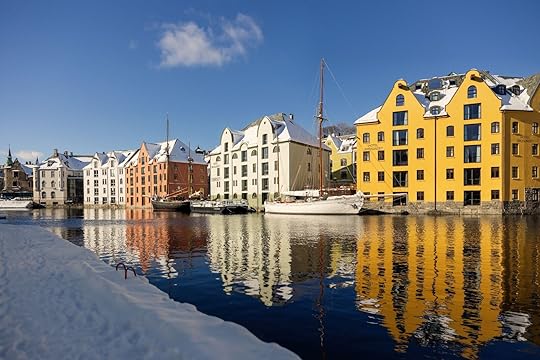
The northern section of Fjord Norway, along the upper west coast, is home to some of the country’s most stunning fjords and mountains. It’s dotted with picturesque fishing towns and villages, and fish are central to the region’s culture, economy, and culinary heritage. Inland, bountiful, sun-drenched farmlands surrounding the fjords are defined by family-run fruit and dairy farms. All of this makes for exceptional restaurants helmed by chefs who honor local ingredients. And it’s a food scene best enjoyed on a road trip.
From the home of klippfisk (salted and dried cod) to the Art Nouveau streets of Ålesund, the route includes stops at orchards, a dairy farm making award-winning cheese, and one of the prettiest chocolate factories on Earth. While food is the highlight, it’s not all there is to experience in this cherished part of Norway — between meals there’s the UNESCO World Heritage site of Geirangerfjord and the famous Atlantic Road.
Kristiansund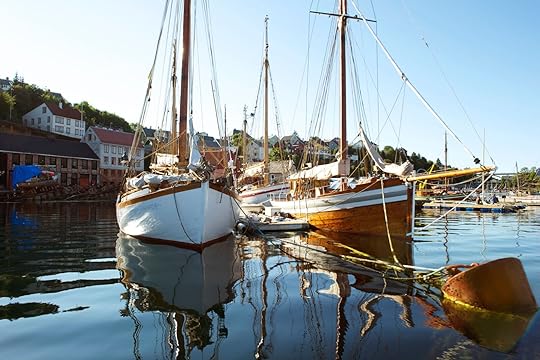
Photo: Visit Northwest/Johan Wildhagen Paolookaville
Start in Kristiansund, a coastal town known for its scenic archipelago, hospitality, and delicious seafood. The town covers four islands connected by the Sundbåten, a free ferry service that has run since 1876. It’s one of the oldest public transport systems still in operation in the world. Take a guided tour on the Sundbåten for a better understanding of the area, its history, and layout. Plus, it’s a lovely way to travel around the different islands — especially on a crisp sunny morning.
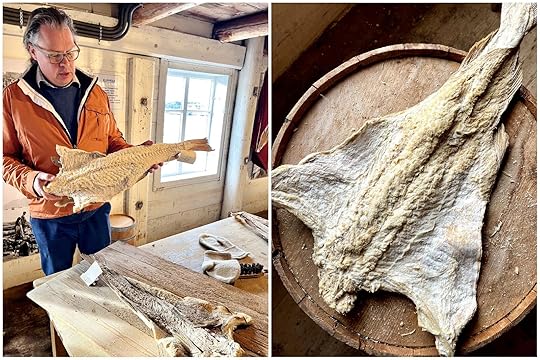
Photo: Katie Scott Aiton
Kristiansund’s heritage is deeply intertwined with the fishing industry, specifically the production of klippfisk. This traditional Norwegian dried cod is made by splitting the fish along its backbone, salting it heavily, and then drying it. Historically, the drying was done naturally in the open air on stone or wooden racks placed on cliffs or other exposed areas (hence the name, which roughly translates to “cliff fish”). With its cold, dry winds, the Norwegian climate is ideal for this preservation technique. The city’s location, harbors, and access to excellent fishing grounds helped klippfisk become a major part of the local economy. During the 18th and 19th centuries, Kristiansund experienced rapid growth, fueled by the export of klippfisk to countries across Europe, the Caribbean, and South America, where it’s called bacalao and remains a staple today. A must-visit to understand this history is the Norwegian Clipfish Museum, where you can take a guided tour through the historic 1749 wharf on the island of Gomalandet.
Where to eat in Kristiansund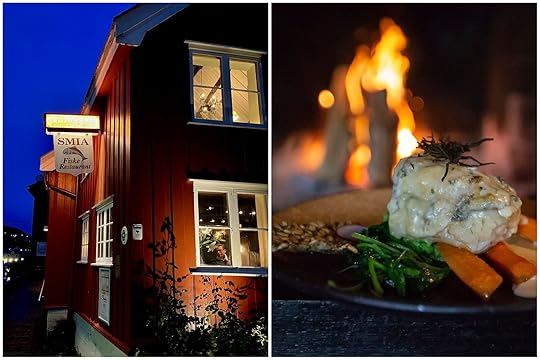 Cozy seafood restaurant Smia near the harbor in Kristiansund.
Photo: Katie Scott Aiton, Visit Northwest/Oddgeir Visnes
Cozy seafood restaurant Smia near the harbor in Kristiansund.
Photo: Katie Scott Aiton, Visit Northwest/Oddgeir Visnes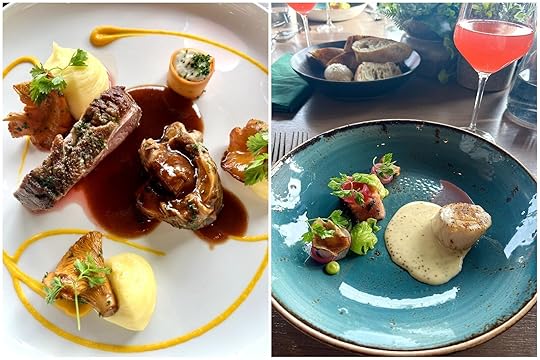 Seared scallops and lamb two ways at Bryggekanten Brasserie.
Photo: Katie Scott Aiton
Seared scallops and lamb two ways at Bryggekanten Brasserie.
Photo: Katie Scott Aiton Lunch with a view of the water at Bryggekanten Brasserie.
Photo: Bryggekanten BrasserieSmia
Lunch with a view of the water at Bryggekanten Brasserie.
Photo: Bryggekanten BrasserieSmiaThis charming harbor-side restaurant’s building has had many lives. The little red wooden structure has been a boat house, a blacksmith workshop, and a dress-making shop. “We don’t really know how old the house is,” says Stian Røsand, head chef, “but it was moved here in 1786.” The restaurant opened in 1994. Renovations have been made, but there are nods to the past that respect the fascinating history of the establishment.
Smia celebrates fish. Meat makes an appearance on the menu, but as it’s in Kristansund, it’s fitting to eat local fish dish.
“Most people come here for bacalao, so we can never take it off the menu,” Røsand says.
In Norway, bacalao refers to more than just the fish itself: it’s a hearty stew made with a tomato base and klippfisk, onions, potatoes, and peppers that add a kick. A house speciality is bacaolao de grip lighthouse. This colorful dish comes in three bowls of red, green, and white bacalao (colors of the lighthouse). The white dish is made with a local Italian-style sausage, the green with ramsløk (wild garlic), and the traditional red with a tomato base.
Klippfisk as its own highlight will always have a place on the menu, too. The klippfisk at Smia is skrei cod, a North Atlantic migrating cod from farther north near Lofoten that’s larger than those found in the fjords around Kristiansund. By keeping it simple, Røsand shares, the hearty dish is similar to what his grandmother would have served. It comes with mashed potatoes, bacon, carrots, and swedes (rutabaga.) Perhaps it was the warmth of Smia’s open fire, the wonderful hospitality, or the food itself, but while eating this I had the comforting thought of my own grandmother.
Smia: Fosnagata 30B6509 Kristiansund, Norway
Bryggekanten BrasserieFor lunch with a view, reserve a window seat at Bryggekanten Brasserie across the harbor from Smia. With a backdrop of the water, you can sit and watch locals coming and going on the ferry. The vista from this pier-positioned restaurant is breathtaking, and the food is exceptional. I enjoyed seared scallops from Hitra (a delicacy from the islands of Hitra and Frøya just north of Kristiansund) with beurre blanc, roe, grilled salmon, pickled squash, sunchoke chips, and dill mayo. This was followed by lamb two ways with glazed carrot puree and a delicious hazelnut cream paired with a glass of the famed pink apple juice by Fjordsider, a cider and juice company from the picturesque Romsdal Peninsula of Norway.
Bryggekanten Brasserie: Storkaia 1, 6509 Kristiansund, Norway
Where to stay: Thon Hotel Kristiansund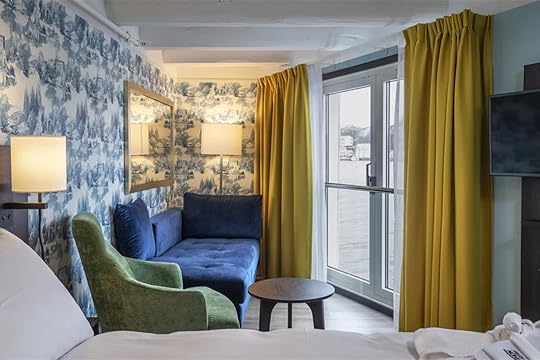
Photo: Thon Hotels
Thon is a chain through Norway, Sweden, and Denmark. I’ve stayed at many throughout my travels in the region and highly recommend a night or two at Thon Hotel Kristiansund. Ask for a room with a harbor view, and you’ll wake to expansive windows that almost feel like you’re standing above the water. Rooms are responsibly priced, comfortable, and have everything you need (an iron, coffee machine, large beds). The service is also excellent.
Thon Hotel Kristiansund: Fiskergata 12, 6507 Kristiansund, Norway
Tingvoll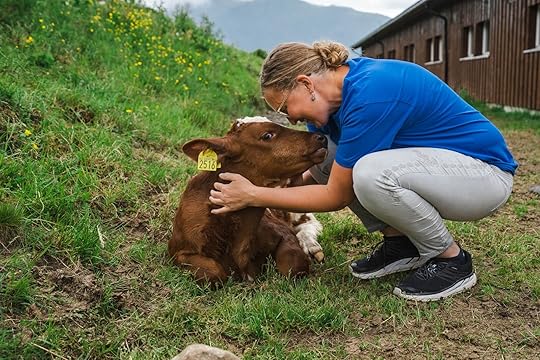
Photo: Visit Northwest/Eline Karlsdatter Fladseth
From Kristiansund, drive one hour through the countryside — peppered with red timber houses, old tractors, and farms — until you reach the village of Tingvoll in Møre og Romsdal county. Fifteen minutes from Tingvoll is the family-run dairy farm Tingvollost, where you can taste (and purchase) award-winning cheeses.
Here, I met Kristin Waagen, whose family has been making cheese since the early 2000s. Waagen shared stories of making cheese for the first time in the farmhouse bathroom, and how she expanded the business and won the World Champion in World Cheese Awards in 2016 for Tingvollost’s Kraftkar blue cheese (not to mention other national awards).

Photo: Katie Scott Aiton, Visit Northwest/Eline Karlsdatter Fladseth
“The way we handle the cows has a lot to do with the taste of the milk,” Waagen says, explaining the dairy’s success as multifaceted. The cows are respectfully given room to roam. Each has its own personality and name, like Ariana Grande (named by her daughter), Fagerli (an old Norweigan name), and Kokos (Norweigan for coconut). “The cows are my friends,” Waagen says with an infectious smile. A life without stress, Waggan remarks, produces the finest dairy, and everyone, including the cows, has a happy life. Despite the success and awards, or perhaps thanks to them, Tingvollost plans to stay at its current production size to retain product quality and keep up with the beneficial animal condiditions.
You can spend a few hours here. If you visit in summer, there are cute outdoor playhouses for kids. Inside the farm shop, you can purchase the mouth-watering, award-winning blue Kraftkar, along with Edel Frue, a mild and sweetish soft cheese, and the nutty, semi-hard Mild Mester.
 Photo: Katie Scott Aiton
Photo: Katie Scott Aiton Photo: Tingvoll Sider
Photo: Tingvoll Sider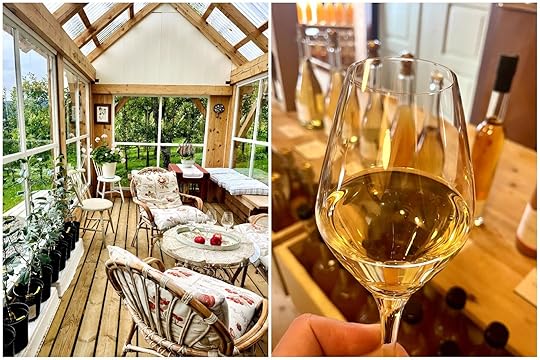 Photo: Katie Scott Aiton
Photo: Katie Scott AitonAfter indulging in cheese, you’ll need something to wet your whistle, so drive 25 minutes onto Tingvoll Sider. Sider (cider in Norweign) production in Norway has grown exponentially since popularity started to rise in the early 2010s. The apple juice and cider I tasted here was the finest I’ve had.
Tingvoll Sider is run by Silje Osnes. The orchard and brewery have only been in operation since 2020, but what started as a hobby with 250 trees quickly became a full-time job for Osnes, an ex-school teacher. Tingvoll Sider has already made serious waves on the international drinks scene, winning two medals in the International Cider Awards and selling out every year. Osnes says she sent a bottle of her cider into the competition in the first year of production simply to get feedback. Little did she know quite how successful she would be, ending up with a silver and bronze and two more awards the following year. Today, the farm has over 2,000 trees producing pesticide-free, old apple varieties.
Osnes is humble when talking about her success, and notes that she’s still learning and loves to collaborate with other experts and breweries in the country. That said, Osnes believes in her product. I enjoyed a few of the ciders: Hustru Gyrid; Strupstadsider; and Sval, the non-alcoholic cider. You can taste the love in every sip. Sealing bottles by hand, Osnes works exceedingly hard to keep up with demand. One of my favorite tipples was the dessert apple wine I drank in the beautiful, light-drenched summer house on the property. Surrounded by baby apple trees, I indulged in a slice of house-made sour cream apple cake with a view over Strupstad farm and on to Breifjorden and Trollheimen.
Hustadvika via the Atlantic Road
Photo: Katie Scott Aiton
You can take your cheese and bottles of cider to your accommodation and call it a day in Tingvoll. If you’re tight for time, jump back behind the wheel and drive toward one of the most famous roads in the world: the Atlantic Road. One of the 18 Norwegian Scenic Routes, this beautiful drive from Tingvoll will get you to the famed Storseisundet Bridge in about an hour and a half. There are multiple stopping points for photos or to sit on the hillside and watch the cars dip over the bridge’s crest and onto the mountains.
I was fortunate on this cold fall day that the weather was behaving, but because it can be unpredictable, stay close by just in case you need to nip back the following day for the view.
Where to stay: Hustadvika Havhotell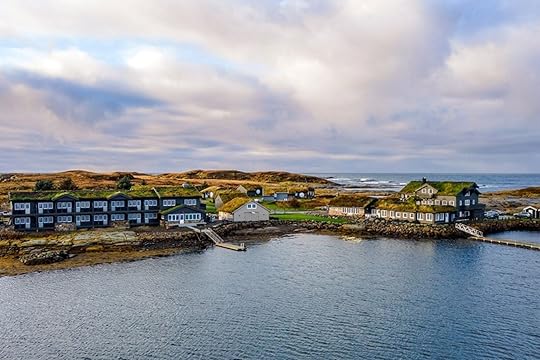
Photo: Classic Norway Hotels
Situated by the coast, Hustadvika Havhotell is a hotel you won’t forget in a hurry. The location feels like the end of the Earth, with views of neighboring mountains and the Norwegian Sea. A pier jots out from the building housing the hotel’s rooms and suites where you can jump off for a morning swim — after an on-site sauna, of course — and there’s a handful of small cabins on the property with a small kitchenette for groups and families. But you might not want to cook. The turf-covered main building houses the restaurant, which you can stroll to from your accommodation. The multi-course tasting menu here champions produce from within a very small radius. The food is excellent, as is the hospitality, making this another place you might find hard to leave.
Hustadvika Havhotell: Storholmvegen 90, 6444 Farstad, Norway
Bud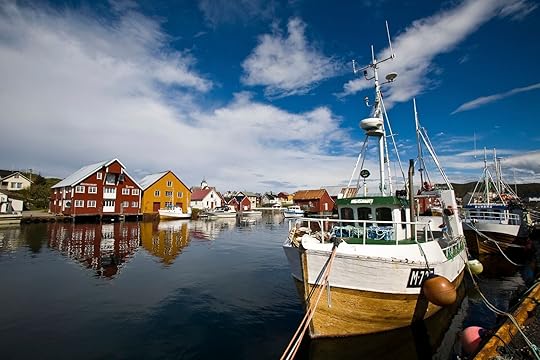
Photo: Visit Northwest/Einar Engdal
The fishing village of Bud is a 15 minute drive from Hustadvika Havhotell, and you can stop along the way for a scenic walk on the beach and to build up an appetite for lunch. Bud is home to Ergan Coastal Fort, which was built and used during World War II by the Nazis and those who fell under their control. Today, you can see remnants of the holding and go on a tour. It also offers cracking views down the coast and over the village of Bud and its colorful timber-clad buildings. You can walk down the hill to reach the restaurant Slipen on the harbor side, and it’s here you’ll have one of the best meals in the region.
Where to eat in Bud Photo: Katie Scott Aiton
Photo: Katie Scott Aiton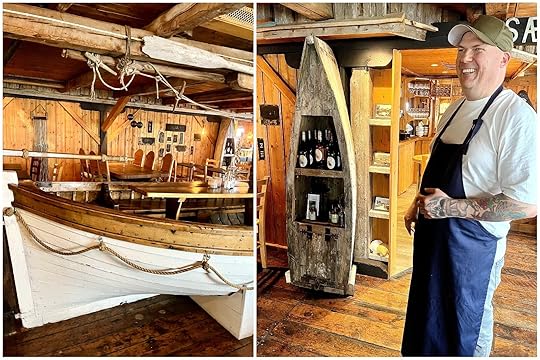 Photo: Katie Scott Aiton
Photo: Katie Scott Aiton Photo: Katie Scott AitonSlipen
Photo: Katie Scott AitonSlipenSlipen is owned and operated by Rune Skeide, a towering man who speaks passionately about the establishment. The building went up in 1890. Skeide shares that it was originally used to offload and store fish in the cellar — hence the name “Slipen,” referring to the slip the boats would use. Skeide opened Slipen in June 2024 and runs an exceptional restaurant upstairs and a bar below.
Slipen focuses on using local ingredients. I ate venison carpaccio, which was hunted five minutes from Bud. Skeide hopes to be nose-to-tail with a butchery downstairs in the future. The main course was wild halibut, caught just off the shore. The story behind each dish only adds to the eating experience. Skeide’s cooking is flawless. Dishes are comforting yet complex, showcasing the skill of balancing flavor and making sure the star of the plate is not lost in pretentious sauces or unnecessary ingredients.
Slipen: Vikavegen 67, 6430 Bud, Norway
ValldalFrom Bud, it’s a three-or-so-hour journey to the next stop, Valldal, a valley in the Fjord Municipality in Møre og Romsdal county that’s known for its outdoor activities and superb fruit-growing conditions. The drive includes a 30-minute ferry from Molde to Vestnes over the Moldefjord. Understandably, ferries are a popular mode of transport in this region. They are efficient, clean, and allow you to stretch your legs and enjoy the water views. Before checking in at Valldal Fjord Hotel, make a beeline for Lingebakken, a family-run fruit, cider, and juice farm. There’s a farm shop where you can pick up a bottle or two of Bakkesider, a delicious spontaneously fermented cider.

Photo: Katie Scott Aiton
The south-facing farm benefits from the sun, and the climate is excellent for growing sweet cherries, sour cherries, plums, apples, and pears. The owner, Elida Linge, is the sixth generation working the land and can organize private tours if you are visiting outside of the July to October fruit season.
Where to stay: Valldal Fjord Hotel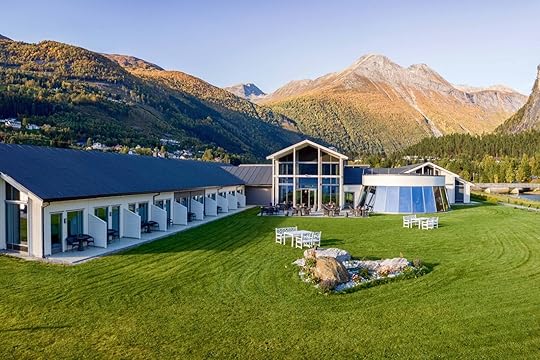
Photo: Valldal Fjordhotell
Valldal Fjord Hotel is another accommodation with a very good restaurant — a theme I’ve appreciated this trip. After a day of driving and exploring, you can rest assured you’ll get taken care of at dinner. In addition to the dining, there’s the jaw-dropping view over the Norddalsfjord and onto the looming mountains from the glass-fronted dining room and lounge from the French doors and private terrace of your room. Snow draped the mountain tops when I visited in September, and sitting by the water with a morning cup of coffee was one of the most cherished moments on this route.
Valldal Fjord Hotel: Grandegata 30, 6210 Sylte, Norway
Geiranger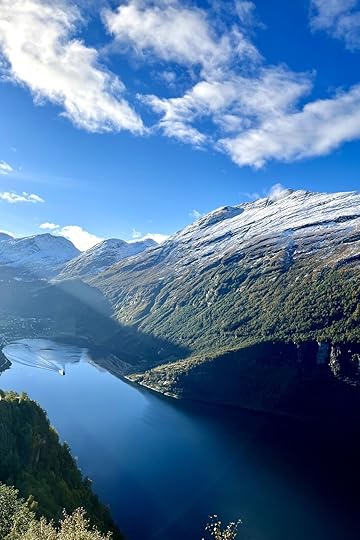
Photo: Katie Scott Aiton
From Valldal, you’re in for one hell of a drive through the UNESCO World Heritage site Geirangerfjord. This route includes Eagle Road, a thrilling stretch with hairpin bends skirting the mountainside. Stop at Ørnesvingen, the highest of these hairpins, and take in the view of all views over Geiranger and the Geirangerfjord.
Geiranger village is situated at the head of the Geirangerfjord. The fjord stretches for approximately 15 kilometers and is hugged by steep, towering mountains that plunge directly into the water. If time permits, consider staying in Geiranger for the night; if not, make time to saunter through the village and stop at local shops such as the chocolate factory, Geiranger Sjokolade.

Photo: Katie Scott Aiton
Here, Swedish-born Bengt Dahlberg crafts delicacies such as the chocolatier’s Academy of Chocolate Awards-winning blue cheese, brown cheese, and whiskey bonbons. Take the opportunity to purchase a box or two for loved ones, and indulge in a chili-spiced hot chocolate if the mood takes you.
Where to eat in Geiranger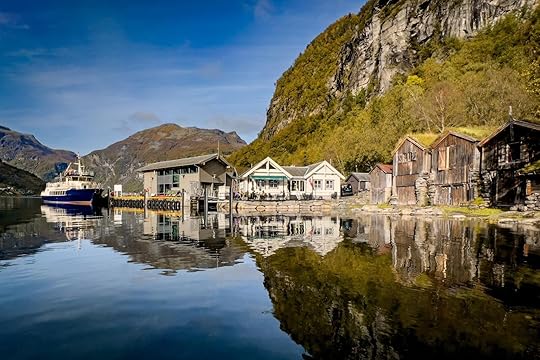
Photo: Brasserie Posten
Brasserie PostenFor a hearty lunch or dinner, go to Brasserie Posten, led by owner and chef Kenneth Løken. It’s situated on the waterfront, with outdoor seating looking out onto the fjord and the old boat houses that line Geiranger’s harbor. In addition to the restaurant, you can also pick up the company’s house-cured and dried sausage. Løken also produces cold and hot smoked trout and a delicious cured trout that I enjoyed topped with beetroot, a side of local sour cream, and homemade focaccia. If the sun is shining and the outdoor area is open, regardless if it’s a little fresh, sit outside during the day and enjoy the comings and goings on Geirangerfjord. For dinner, you’ll be treated to dishes such as slow cooked reindeer, warming fish soup with herb-baked rainbow trout and mussels, and a range of pizzas (including one topped with white nduja, pickled borretane onion, and pesto).
Brasserie Posten: Geirangervegen 4, 6216 Geiranger, Norway
Ålesund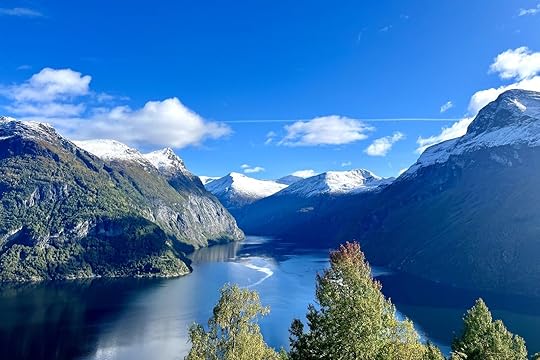
Photo: Katie Scott Aiton
When you’re ready to leave Geiranger, hop on the car ferry and cross the Geirangerfjord to Hellesylt. This ferry is privately owned, so it’s a little more expensive than others on this route. In return, you get a scenic sail through some of the most beautiful scenery in the region, including the famous Seven Sisters waterfalls, which cascade down the mountain. From Hellesylt, it’s another picturesque drive (about two hours) to the town of Ålesund.
 Photo: Destination Alesund and Sunnmore/Kristin Stoylen
Photo: Destination Alesund and Sunnmore/Kristin Stoylen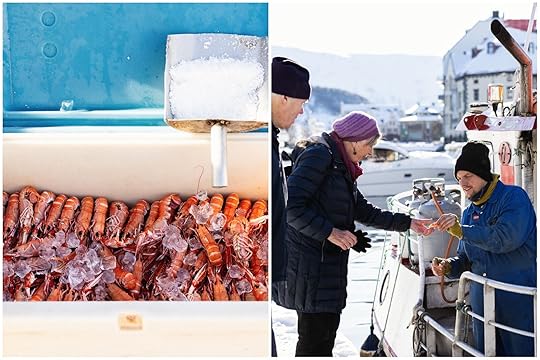 Photo: Destination Alesund and Sunnmore/Kristin Stoylen
Photo: Destination Alesund and Sunnmore/Kristin Stoylen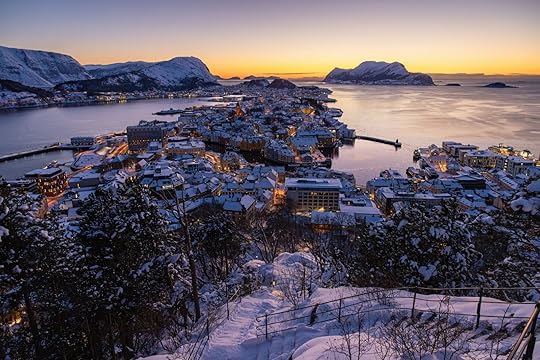 Photo: Destination Alesund and Sunnmore/Kristin Stoylen
Photo: Destination Alesund and Sunnmore/Kristin StoylenStay in Ålesund for a couple of days, at least. I was only here for one, and I wish I had more time. Admiring its colorful Art Nouveau architecture could fill a day alone. The coastal town has a fascinating history. Devastated by a fire in 1904, Ålesund was rebuilt in an Art Nouveau style, earning it the nickname “Paris of the north.” While walking the cobbled streets, remember to look up at the building’s details, and you’ll be offered a glimpse into a bygone era of elegance and innovation. For food lovers, shopping here is a delight. It’s home to one of the best butchers in the region, where I picked up some cured reindeer sausage, and lots of little delicatessens selling everything from local coffee to cured fish, cheese, salt and seasonings, and kitchenware. In the morning, go early to the harborside to meet the crab and shrimp boats. Here on the pontoon, I tasted the sweetest crab, which you can purchase directly from the fishermen.
Where to eat in Ålesund: Sjøbua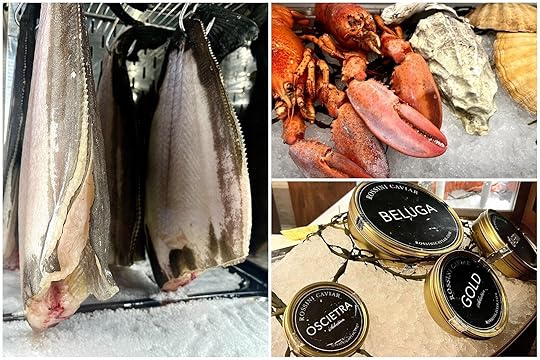 Photo: Katie Scott Aiton
Photo: Katie Scott Aiton Photo: Katie Scott Aiton
Photo: Katie Scott Aiton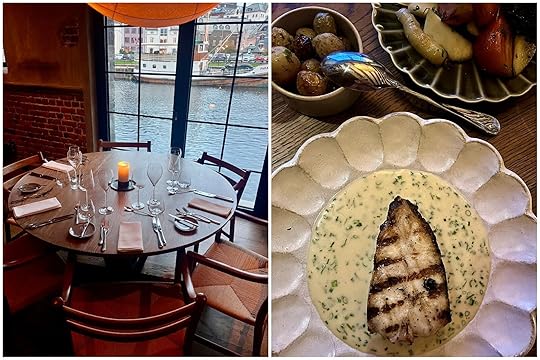 Photo: Katie Scott Aiton
Photo: Katie Scott AitonYou’re spoilt for choice when it comes to dining, so again, if you can, take your time in Ålesund. For a memorable experience, reserve a table at Sjøbua in the fish packing district. Sjøbua, at a glance, is fine dining, yet when you enter, you’ll feel instantly comfortable. There’s a balance of brilliance of service, Michelin-star level cooking, and a beautiful ambiance to make dining here feel special yet unpretentious. My culinary journey began with grilled langoustine from Midsund with fermented leek, tarragon, and Rossini caviar. Buerre Blanc topped grilled halibut made a difficult decision for a main a little easier, and I finished with the most exquisite poached pear coated in caramelized white chocolate.
Sjøbua: Brunholmgata 1, 6004 Ålesund, Norway
Where to stay: Hotel Brosundet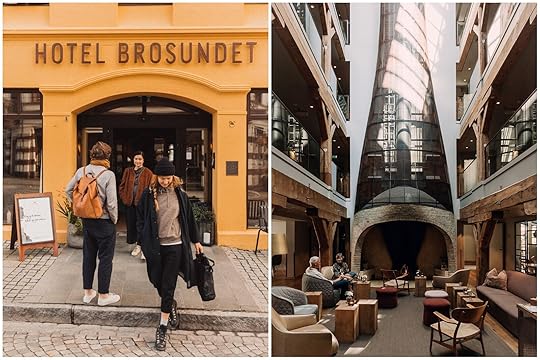 Photo: Hotel Brosundet/Brandon Scott Herrell, Maroy Klouda
Photo: Hotel Brosundet/Brandon Scott Herrell, Maroy Klouda Photo: Hotel Brosundet/62 Degrees North
Photo: Hotel Brosundet/62 Degrees North Photo: Hotel Brosundet/62 Degrees North
Photo: Hotel Brosundet/62 Degrees NorthMy heart ached as I walked into the lobby and took in the three-story, floor-to-ceiling fireplace at Hotel Brosundet. I yearned for more time. A stay here made leaving Ålesund harder, a testament to the warm service, the intimate atmosphere, and the stylish-I-want-this-in-my-home decor. A former warehouse, the hotel was renovated in 2017, and its quayside location puts it within strolling distance of Sjøbua and the cobbled streets of the main town. Many rooms offer views over the ocean. Waking up here feels more like a luxury retreat than an inner-town hotel. In the evening, sit at the copper-clad Arkivet Bar and eat at Apotekergata No.5, the hotel’s brassiere, which was buzzing with life during my stay. The pièce de résistance is the spa’s harborside outdoor bathtubs, which you can reserve and melt into the bubbles as you watch the fishing boats come and go.
Hotel Brosundet: Apotekergata 1, 5, 6004 Ålesund, Norway

October 22, 2024
5 Ozarks Adventures in Missouri That Prove Conservation Can Be Fun
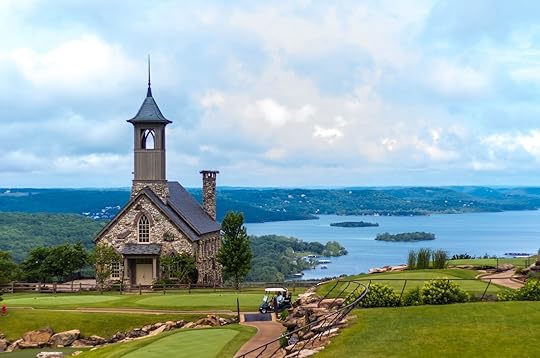
Missouri is known for barbecue in Kansas City and arts in St. Louis, but my trip to the state’s southwest corner was steeped in the nature and history of the Ozarks via a series of Johnny Morris Conservation Foundation attractions.
Inspired by the Teddy Roosevelt-style conservation movement of the early 20th century, the Johnny Morris conservation attractions aim to protect land, connect people with nature, shed light on history, and support outdoor recreation. The foundation honors Roosevelt’s ardor for hunting and fishing while creating ample opportunities for anyone to grow their appreciation for wildlife.
As an ecologist, I was enthralled by the foundation’s Ozarks adventures and eager to patronize a nonprofit with a conservation mission. Here’s how you can, too.
Catch a sunset at the Top of the Rock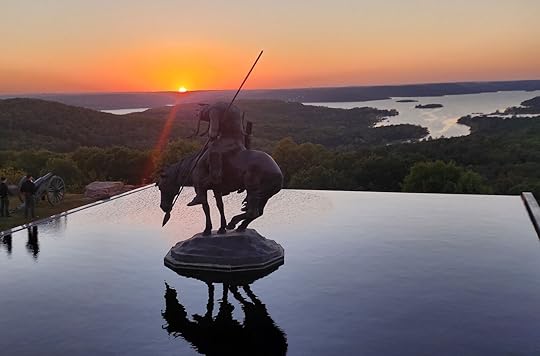
Photo: Devin Reese
I started my adventure in the late afternoon at Top of the Rock Ozarks Heritage Preserve, which contains a view from the highest point in Missouri’s Taney County. Every evening between April and October, a Sunset Celebration signals the sun’s setting over the sweeping vista of Table Rock Lake, a dammed portion of the White River. After bagpipes hum, a Civil War cannon sends a billow of smoke into the sky, which drifts past the striking statue of a member of the Osage Nation astride a horse (a replica of “End of the Trail” by American sculptor James Earle Fraser).
If you come before sunset, you can drink or dine at the Osage Restaurant and be well positioned for the Sunset Celebration. The restaurant has its own kind of majesty, crafted from massive timbers and rocks, and adorned with artistic touches in glass and metal. The elegant dining experience starts off with homemade breads, including flatbread crusted with seeds, which I chased with wood-fired artichokes and a melt-in-your-mouth macadamia-nut-crusted sea bass. A couple of other restaurants on site offer more casual dining.
Top of the Rock: 150 Top of the Rock Rd, Ridgedale, MO 65739
Cruise through the Lost Canyon
Photo: Devin Reese
I returned to Top of the Rock the next day. There’s a lot that you can do there, but my husband and I opted for the Lost Canyon Cave and Nature Trail: 2.5-mile golf cart tour that sticks to a paved trail while riders take in a variety of natural and manmade landscapes along the way. The trail passes waterfalls decorated with lights and larger-than-life animal sculptures. In some spots, you see stacked dolomite rock formations that are typical of the region’s geology. The tour’s eponymous limestone cave no longer houses bats, but you drive right past the on-theme Bat Bar in case you need refreshments. So, while it’s anything but “lost,” the experience is fun, imaginative, and accessible to people with physical limitations.
Lost Canyon Cave and Nature Trail: 150 Top of the Rock Rd, Ridgedale, MO 65739
Dive into the history of the Ozarks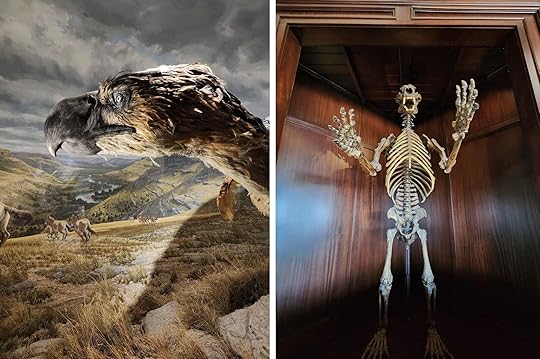
Photo: Devin Reese
Also at Top of the Rock is the Ancient Ozarks Natural History Museum. You start in a dramatic atrium dominated by a wooly mammoth skeleton and flanked by fossil skeletons of other animals that long ago inhabited the Ozarks, including the short-faced bear. Then you descend into a maze of displays that tell a story of Osage life through a remarkable collection of artifacts, including arrowheads, peace pipes, clothing, and pottery. I was drawn to the hand-painted dioramas showcasing specimens of the intimidating animals that live alongside humans, like the Titanis “terror bird,” an apex predator that stood about six feet tall.
For history buffs, as you continue through the museum, you encounter artifacts from Indigenous tribes across the country, as well as Civil War objects.
Ancient Ozarks Natural History Museum: 150 Top of the Rock Rd, Ridgedale, MO 65739
See where elk and bison roam
Photo: Devin Reese
A half-hour drive west from Top of the Rock is Dogwood Canyon Nature Park, encompassing 10,000 acres of Ozark Mountain habitat. You can tour the park on foot, bike, or horseback. Regardless, you’ll be immersed in a forest that harbors native wildlife; I saw several armadillos, pond slider turtles, and my first mink. To see the herds of elk and bison, you go by tram (also a great option for anyone with limited mobility). The tram crosses state lines into Arkansas, where you have unobstructed views of the captive herds. Fall was a great time to visit since it’s mating season when the elk males keep their harems of females in line by strutting around and bugling (making a loud wailing sound to mark their territory and attract mates).

Photo: Devin Reese
Dogwood Canyon is a favorite haunt of fishermen; its streams are maintained as optimal habitat for rainbow trout, which gather in greenish pools under waterfalls that give them natural aeration. We also popped our heads into several places near the entrance to Dogwood Canyon. There’s a working mill offering a glimpse of the way things were done in bygone days. The miller explained how the machinery was assembled – including a heavy grinding stone – to grind the reddish corn into “bloody butcher grits.” Outside, powered by the flow of Indian Creek, the water wheel turns the gears.
We climbed the spiral stairs to the Treehouse, a lovely, educational hang-out spot. The staircase featured labeled wood and bark from local tree species, while cupboards contained information about area birds. From the Treehouse, you cross a footbridge to the Conservation Center, an expansive building offering classrooms and lots of educational materials, including sticks from a real bald eagle nest, as well as animal specimens, books, and interpretive signage.
Dogwood Canyon Nature Park: 2038 State Hwy 86, Lampe, MO 65681
Get farm-fresh fare at the source
Photo: Devin Reese
We ended our trip at Finley Farms & The Ozark Mill, a restored property along the banks of the Finley River most of the way northward toward Springfield. Perched unexpectedly at the corner of commercial streets, it’s a serene oasis from modern life, a working farm with flowers, bees, crops, and opportunities to learn about sustainable agriculture.
Several restaurants on site feature the farm’s fresh produce. We dined at The Garrison, a secretive, dim space under the mill that required a password to enter. You’re like a time traveler to the 1920s inn that was purportedly busted several times for serving alcohol during Prohibition. I ordered the Pisco-based Millpond cocktail (light and delicious), while my husband savored the rich Ozark Beer Company Cream Stout. The dinner was spectacular, starting with a whipped honey goat cheese, plus beet and blackberry salad, followed by a main of red snapper bathed in red curry broth. By the time we dipped into the persimmon crème brulee for dessert, we were bowled over by the chef’s talent.
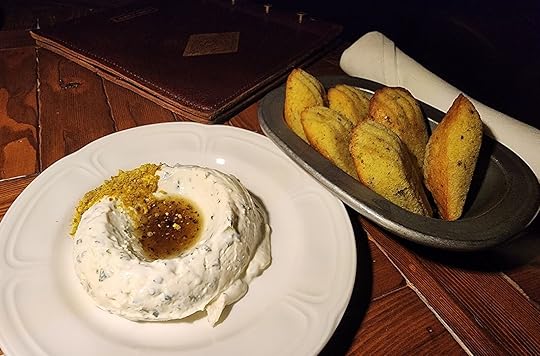
Photo: Devin Reese
Breakfast at Finley Farms the next morning was equally inspired. We ate at The Workshop, a 1930s industrial garage transformed into a cafe doubling as a workshop space (where you can learn to make elderberry syrup, for example). In the beautiful fall weather, the garage doors were wide open, offering a view of the rows of crops. My avocado toast came on homemade bread topped with arugula from the farm. With aromatic coffee in hand, you could browse a small gift shop of handcrafted goods or go outside to play cornhole (which I won, by the way).
Finley Farms & The Ozark Mill: 802 Finley Farms Ln, Ozark, MO 65721
Where to stay on your Ozarks adventureAngler’s Lodge, HollisterView this post on InstagramA post shared by Big Cedar Golf (@golfbigcedar)
One of three Bass Pro lodges in the area, this one is well-located for exploring the attractions south of Springfield. When you enter the commanding building, you’re transported to a space where Teddy Roosevelt might have felt comfortable. The décor pays homage to natural resources, from the photographs of wild areas to deer antler ceiling fixtures. But there’s no lack of modern amenities, including an indoor pool, fitness center, and fast WiFi. The 24-paned windows in the bedrooms let in lots of light.
Angler’s Lodge: 291 Financial Dr, Hollister, MO 65672
Calm Waters ResortView this post on InstagramA post shared by Calm Waters Resort (@calmwatersresort)
For budget travelers who fancy a rustic experience where you can use an outdoor grill or indoor kitchenette to prepare their own food, these cabins are perched right on Table Rock Lake. Each cabin has a porch with seating and a dock nearby with free access to paddleboards, kayaks, and other watercraft.
Calm Waters Resort: 1043 Jakes Creek Trail, Branson, MO 65616
Getting to Springfield and around the OzarksI flew into the Springfield-Branson National Airport (SGF), which is small and easy to navigate, and rented a car. The best way to get around is by driving since the Johnny Morris attractions range from Springfield to more than an hour south. 
‘Atlas Obscura: Wild Life’ Is a Fun Encyclopedia of Our Planet’s Weird and Wonderful Flora and Fauna
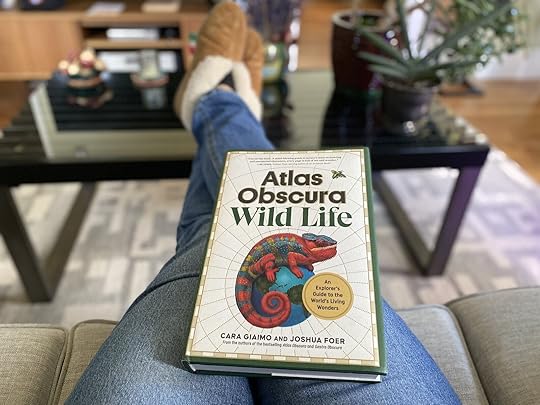
We hope you love the books we recommend! Just so you know, Matador may collect a small commission from the links on this page if you decide to make a purchase. Listed prices are accurate as of the time of publication.
I have wildlife on the brain after a recent life-changing trip to the Galápagos Islands. Yet with winter firmly on its way, the little mountain town where I live in British Columbia, Canada, is pretty short on animals. The bears, skunks, marmots, snakes, frogs, and even the bumblebees are getting ready to hibernate or otherwise make themselves scarce for the next few months, and all that’s left for me to look at through my binoculars are chickadees and the rare white-tail deer passing through my yard.
To remedy my feelings of wildlife withdrawal, I’ve resorted to re-watching David Attenborough documentaries and reading, for the the umpteenth time, what I consider to be my personal wildlife and conservation Bible: Last Chance to See, a funny and fascinating book by Douglas Adams and Mark Carwardine. At least I was until I received Atlas Obscura: Wild Life: An Explorer’s Guide to the World’s Living Wonders (2024, Workman Publishing Company) in the mail. Now, that’s really filled my cup.
Atlas Obscura: Wild Life is the third travel book put together by the Atlas Obscura team. The first book, Atlas Obscura: An Explorer’s Guide to the World’s Hidden Wonders (2016), focused on extraordinary places and how to see them, and Gastro Obscura: A Food Adventurer’s Guide (2021) concentrated on unexpected dishes and culinary traditions and where to experience them. Like those two volumes, Atlas Obscura: Wild Life is a coffee table book that spotlights the strange and surprising, but this time, it’s all about our planet’s fauna and flora. And there’s a lot to cover.
Buy: $28Organized into seven chapters, each covering a different ecosystem, Atlas Obscura: Wild Life consists of 457 pages of fun facts and captivating explanations about the most bizarre creatures and plants that we share the planet with. The texts are short, and just about every entry is illustrated by colorful photographs and artwork. Also, this is not the kind of book you read through from cover to cover — it’s better enjoyed slowly and bit by bit over the space of weeks, months, or even years. Just leave it to rest near your couch or a comfy armchair, and pick it up when you want to be blown away by all curious living things that make up our world.

Reading the Galapagos Islands section of Atlas Obscura: Wild Life. Photo: Morgane Croissant
Due to my current obsession with the Galápagos Islands, I opened the book and went straight to the island section, which is the seventh and last chapter of this volume. Two double pages are dedicated to the archipelago and its unique inhabitants, and I hurried to read them. Despite having just spent seven days on site accompanied with two incredibly knowledgeable naturalist guides, I learned a few new things, including the fact that there are beautiful-looking and endangered land snails on the islands, and that ladybugs have been introduced to the Galápagos as recently as 2002 to control an invasive species. Who knew? Certainly not me. I also got to see and read about a bird that I unfortunately never managed to encounter during my trip: the vampire finch. The bloody photos used to enrich this entry are not for the faint of heart.
When I read everything there was to read about the Galápagos Islands, I flicked through the pages at random. I landed at the chapter dedicated to the fauna and flora living in the world’s cities (chapter six), and learned about the two-ton hippopotamus that wanders the streets of St. Lucia, South Africa, every night to come and munch on people’s lawns. Another random browse through led me to the chapter covering grassland and tundras (chapter two), where I was reminded of the deadliness of the Indian cobra and the unique eye-like pattern featured on its hood. No matter what chapter or page you choose to read, you’re sure to run into something odd and enchanting you’d never heard about before.
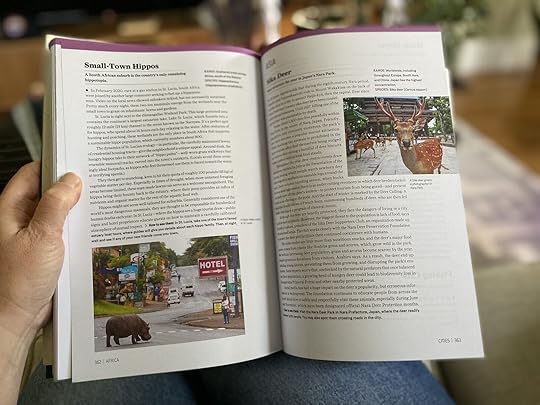
Photo: Morgane Croissant
Besides the wealth of knowledge that fill the pages of Atlas Obscura: Wild Life, what I like best about this book is the precise yet casual approach to zoology and botany that the authors took. There’s no jargon or long-winded scientific explanations to be found. The descriptions and photo captions are concise, simple, and humorous, making this book accessible to all, even those whose last biology class was 20 years ago.
Here’s an example of the authors opting to use straightforward language and a relatable comparison to describe the very unusual-looking bleeding tooth fungi:
“Squint and cock your hear to the side, and you can convince yourself that the red goo on its cap looks like raspberry jam on an English muffin, or perhaps the bedazzled head of a cauliflower.”
Another element that makes this book special are the dozens of mini expert interviews found at regular intervals in each chapter. From an ocean entomologist to a moss-gathering mountaineer, a tortoise adoption coordinator to a crow-human conflict mediator, you’ll get inside knowledge of what it’s like to work among the unique fauna and flora described on the pages.
You don’t have to be a wildlife-watching expert, an animal lover, or even a world traveler to enjoy Atlas Obscura: Wild Life, you only need to be curious and open to the fact that the world we live in is a weird, wonderful place that’s worth exploring and preserving.
Atlas Obscura: Wild Life is available now on Amazon and Kindle. 
This Airport Has a 3-Minute Hug Limit When Dropping Off Loved Ones

In a bid to improve safety and traffic flow at its drop-off zone, Dunedin Airport, located on New Zealand’s South Island, has introduced an unusual rule: a three-minute cap on farewell hugs. I’m sure The Prime Minister in Love Actually would be as displeased as I would be if I felt rushed to say farewell to family and loved ones.
Airports bring out the best and worst in people. In such a controlled space, you can witness the full spectrum of emotions. I’ve had goodbyes, which have been some of the hardest moments of my life. After living overseas for most of my adulthood, it was the part of the trip home that filled me with dread. Hugging my parents and siblings and not knowing how long it would be before I’d be able to do that again was a horrific experience. If I had been told at that moment to speed things up, let’s just say I would have shown my not-so-nice side.
At Dunedin Airport, the warning sign has been erected in the drop-off zone. It warns passengers, “Max hug time three minutes. For fonder farewells, please use the car park.”
View this post on InstagramA post shared by Dunedin Airport (@dunedinairport)
The airport’s chief executive, Dan De Bono, tells Radio New Zealand that the rule was introduced to address the issue of passengers taking too long in the drop-off zone, hindering traffic flow and potentially causing safety concerns.
“We’re trying to have fun with it,” De Bono says. “It is an airport, and those drop-off locations are common locations for farewells. But there’s no space left for others.” He adds that some travelers have been taking too long at the drop-off zone, which the airport deemed inappropriate.
The new rule has sparked a lively debate on Facebook, with critics arguing that it is “inhumane” and an invasion of privacy.
Others have praised the airport for its lighthearted approach to the issue, especially when many airports worldwide have unreasonable drop-off fees.
“I love it,” says a Facebook commenter. “It shows warmth and compassion. At my local airport, it would be “you can’t stop there.” There’s a $130 fine if you stop and a minimum of $6.50 to drop someone off in the drop-off zone.
While one person questions who would want to hug someone for three minutes, others share slogans from similar signs at their local airports. Erica Ra from Aalborg, Denmark, posts a photo showing the sign at Aalborg Airport, which reads, “No kisses above three minutes.” Nice in France and Split in Croatia also have a “Kiss and Fly” zone encouraging passengers to pucker up and move on.
Back in Dunedin, De Bono clarifies that the airport does not have a dedicated “hug police” to enforce the rule. Instead, staff will politely remind passengers to move to the car park if things get a little too emotional and hugs go on too long. 
October 21, 2024
Protecting the Amazon: Activist Nemonte Nenquimo on Her New Book ‘We Will Be Jaguars’

When Nemonte Nenquimo, a member of the Waorani people, was growing up in Ecuador’s Amazon rainforest, white people were a rarity. One missionary lived in the village, and she exerted control over some of the Waorani people with threats of god, shame around nakedness and traditional ways, and selectively providing medicines. Planes would fly in with more white people who came looking to expand extractive logging and oil industries. Nenquimo always rushed to see the planes land as a child, though at the time there was no way for her to know just how much these interactions would shape her personal life and her work protecting her people’s land.
The Amazon rainforest and the Indigenous peoples who have historically called it home face a litany of threats from governments and big industry. Those same threats are increasing the impact of climate change — a problem that will only exacerbate the challenges to protect the land in a vicious circle.
Nenquimo is a climate change activist and cofounded the Ceibo Alliance, which has members of the Waorani, Kofan, Secoya, and Siona peoples. She is also a cofounder of Amazon Frontlines with her husband Mitch Anderson. The organization has both Indigenous and Western members and was founded in 2011 to promote local-led conservation in the Amazon. Nenquimo helped lead a court case to protect more than 500,000 million acres of rainforest that the Ecuadorian government was attempting to auction off to oil companies, with precedent to protect millions more. Her work is widely recognized, and Amazon Frontlines won the Goldman Environmental Prize in 2020 and the 2024 Conrad N. Hilton Humanitarian Prize — in the case of the latter, it was the first organization of Indigenous and Western activists to win the largest annual humanitarian award in the world.

Photo: Amazon Frontlines
Buy: $28Nenquimo’s new book, We Will Be Jaguars (Abrams Press), cowritten with Anderson, tells her story and the oral stories of her people. It starts with her childhood living in a village called Toñampare with 30 to 40 families and one white person living with them: a stern and racist missionary named Rachel Saint trying to “save” the tribe through god. Nenquimo recalls personal traumas of being sexually abused while studying with a missionary group, and the devastation to her people’s way of life she saw when she returned. The book also records long-held oral traditions, and recounts her meeting with Anderson, who was building rainwater catchment systems in the Amazon, and the work they’ve done together.
The constant threat of industry, government, and climate change are present throughout.
“I decided to write my story in a book because I know that we’re all connected to Mother Earth,” Nenquimo told me over a video call, with Anderson translating from Spanish. “We’re all connected in our actions, and what people do far away affects what happens in my lands and in my territory. And what happens in my lands and my territory and my home can affect people far away.”

Nemonte Nenquimo and Mitch Anderson. Photo: Christopher Fragapane/Amazon Frontlines
Here, Nenquimo explains recording oral traditions, her work to protect the Amazon and Indigenous cultures, and what she has hope for in the future.
This interview has been edited for length and clarity. Answers were translated from Spanish during the call by Mitch Anderson.
Matador Network: From the start, the book acknowledges that the stories in your oral tradition are sacred. What led you to believe putting them down in a book is the right choice?Nemonte Nenquimo: We didn’t write this book because we dreamed of writing a book. We are activists, we have been working for many years with different peoples and my people. We’ve been protecting our lands and defending our lands against external threats for hundreds of years. Over the last decade, these threats have been intensifying, and working with Mitch, cofounders of Amazon Frontlines, and the Ceibo Alliance, we’ve worked together with Indigenous nations across the Upper Amazon to win big battles against the mining industry, against the oil industry, against the government.
After winning these big battles to protect our lands, we realized the threats continued unrelenting. My father and our elders are wise and they’ve taught me that the outside world destroys what it doesn’t understand. Our book is not a book like that of an anthropologist asking questions every day who comes from outside. With my dad, my family, and our elders, we thought that putting our stories into a book would be an act of resistance — a strategy that could help the world understand who we are as Indigenous peoples, our connection to our forests, and why the outside world shouldn’t destroy it.

Photo: Christopher Fragapane/Amazon Frontlines
For the Waorani, we remain unconquered for thousands of years because we live in the heart of the Amazon and we were always careful to not walk the same trail twice. We would always walk a trail and then we would come back along a different trail. That was my dad’s advice to me when we wrote my story, our story, down: to make sure that I wasn’t walking the same trail and exposing my people or ourselves to potential dangers.
In the process of writing my story down and discovering the story that needed to be told, it was also powerful and healing. It’s a love story about and to the land, to my people.
What has the response to your work and to your book been from the Waorani people?This is the first book written by our people, written by an Indigenous woman, sharing my perspective, my voice, my understanding of the world and how my people live in the forest, how we perceived the outside world’s invasion of our lands. They’re proud because it’s a story that honors our culture, love for the land, and our ancestors.
The book is deeply personal as well. How do you feel that your personal story helps people understand the bigger problems happening in the Amazon?Because Mother Earth is suffering, because Mother Earth is wounded, because Mother Earth is carrying a tremendous amount of pain. Because the missionaries invaded our lands and caused harm, because the oil companies invaded our lands and caused harm, because the government has invaded our lands and caused harm, and because women are the earth. Our bodies are made from the earth. We are the life givers, just as the earth is the life giver.
And because I suffered violence, trauma, and sexual abuse, I needed to share that pain. Because it’s the same pain that Mother Earth is feeling.

Photo: Amazon Frontlines
To be a leader, one needs to have courage, one needs to be without fear. And because ultimately I wanted to communicate our lived experience as Indigenous peoples with the world truthfully and honestly.
The fight to protect the land has changed over time. Can you explain those changes?It is not the same as before. Before, it was a small threat. They killed with the spear if it entered their territory. But now, we Indigenous peoples are the solution to climate change. We don’t destroy, we don’t pollute, we are our home. We are in spiritually in contact with Mother Nature. What is now a threat is outside. It is the system of the world, of the economy.
From the very beginning, when there was an external threat to our people’s lands and our territories, our ancestors went to war. We brought our spears into war and into battle to protect our lands. But what we realize now is the scale of the threats, the nature of the global economic system, is such that spears are not enough to protect our land. And so the decision to tell our story and write it in a book is an act of resistance, a way of building a movement.
It’s a way of sparking awake consciousness worldwide. It’s a way of ensuring that many across the world will have our backs because we’ve shared with those that want to destroy us who we are and our connection with the land and our claim over this territory. There’s no change, no contradiction, in the essential wisdom. What there is is us innovating and adapting our strategies to protect what we love.
What do you see as the defining approach Westerners took to “save” the Amazon and the people who live there?Many times, evangelicals, oil companies, government officials, and NGOs come and see the Indigenous peoples as, “Oh, poor thing, the Indigenous people have no knowledge, we can help.” They put their ego, their arrogance toward the Indigenous people without understanding. They suppose that Indigenous peoples need to be saved and that they can’t save themselves.
The mentality of the savior is not a curious mentality. They’re not interested in asking questions or trying to understand the visions of the people, what well-being and health mean to the people. What they’re interested in doing is imposing their own project or their own agenda.
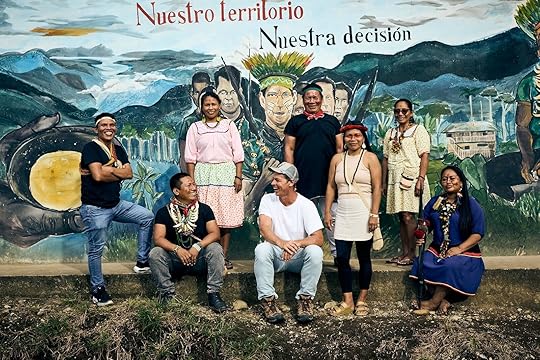
Mitch Anderson and Nemonte Nenquimo, center, with partners from Ceibo Alliance. Photo: Christopher Fragapane/Amazon Frontlines
The relationship with the team from Amazon Frontlines, who are also outsiders from around the world, was very different, because they didn’t start with an arrogant, superior mentality. They started with a big heart and a big desire to listen and to learn, and figure out how to be useful and meaningful and supportive in their work to protect Indigenous cultures and Indigenous territory against the threats that come from the very system where the outsiders come from. It’s been very powerful. With that approach to collaboration, as opposed to imposition, we’ve been able to create really big dreams, very formidable strategies, and a lot of impact and benefit to communities, the rivers, to the forest.
There’s so much extraction, of people and the land, that runs through the book. How have things changed in recent years?The first thing that’s important is that through collective struggle — through the work of Ceibo Alliance and Amazon Frontlines, through the wisdom and power of the elders, the Waorani people, and the women — we were able to win an important battle against the government and the oil industry to protect 500,000 acres of Waorani territory and set a legal precedent to protect 7 million acres more.
And that’s powerful, and that is a reason to hope, because we provided a tool for Indigenous peoples to protect their land. We’ve also won a national referendum to keep the oil in the ground in Yasuni National Park, which is also another powerful sign of hope. But at the same time, over the last years, the government and the oil industry and the mining industry is doubling down on extraction.

Photo: Karen Toro/Amazon Frontlines
The threats continue to intensify. And as Indigenous peoples who call and consider the Amazon our home, we’re connected to the forest from the moment we’re born and into the afterlife. The forest is our pharmacy, it’s our market, it’s our hardware store, it’s our source of life. We’re going to continue defending our home from these threats.
And the reason why we’ve written this book, We Will Be Jaguars, is because we will be jaguars. It’s because we realize that these threats are systemic and they’re coming from a deep place of spiritual disconnection with Mother Earth.
The world of the cities, the people of the cities, are disconnected from the land spiritually, and are desiring to accumulate and accumulate and accumulate more and more consumption, consumption, consumption. And that is driving these threats to our forests and to our homes. And so we’ve written this book as a love letter to Mother Earth, and as a wake up call to the world that we need to spiritually reconnect, love, and honor the life giving Mother Earth.
Otherwise, we’re going to continue to threaten her, which will threaten our very survival.
Amazon Frontlines was recently awarded the Hilton Humanitarian Prize. What does that say about the state of the movement and where things are headed?We deserve this recognition. Indigenous peoples for centuries have been defending our lands, suffering injustices, protecting our rivers and our forests. We deserve this prize. Indigenous peoples need to be recognized, need to be seen, need to be uplifted. We deserve 20 more prizes. We deserve all the prizes in the world for everything that we’re doing to protect our homes.
And for us, what we’re going to do with this recognition is continue to grow our work, continue to protect our territories, continue to protect our land. And we’re going to work to wake up the world so that we don’t destroy the only mother that we have.
For more, We Will Be Jaguars is available now on Amazon and Bookshop.
What It’s Like to Stay at the New Populus Hotel in Denver

No hotel opening in the western United States has been more anticipated in 2024 than Populus, the new 265-room, 13-story high-end property off Denver’s Colfax Avenue. Populus promises to be the world’s first “carbon positive” hotel — an eco-first mantra aimed at the growing specter of climate-conscious travelers and the growing demand for all types of professional travel, from conferences to concerts, to be done with less environmental impact. I spent two nights at Populus the week the hotel opened, staying in a corner suite on the sixth floor and experiencing each of the hotel’s food and beverage concepts. I’m a travel editor who oversees hospitality content and who regularly reports on sustainable travel. I’ve never stayed in a concept more smugly auspicious — nor one that better delivers on its promise.
How Populus’ ‘carbon positive’ claim stacks up in reality
A facade that commands attention. The “aspen-eye” windows both amplify and filter natural light, and help to optimize the building’s temperature. Rendering courtesy Populus
Central to the appeal of Populus is its claim to be the first “carbon positive” hotel. For this to be true, the hotel must sequester more carbon than it emits. The promise is built around the utilization of renewable energy, the elimination of food waste (a powerful emitter of greenhouse gasses), and a massive tree planting initiative to offset and exceed what carbon the property does emit.
The name “Populus” comes from the scientific name of Colorado’s native Aspen trees, populus tremuloides. The hotel’s design builds on this, with a library stacked with books about regional biology and wildlife, The windows are designed to resemble the “aspen eye” peepholes common in tree trunks on the whitish bark of aspen trees, but also serve a function – the “eyelids” above and below them filter heat and light to optimize the building’s heating and cooling efforts while simultaneously providing a unique viewing experience to guests.

Looking through an “aspen eye” to the Denver City and County Building, lit up to perfection. Photo: Tim Wenger
Key to the “carbon positive” aspect of Populus is its “one night, one tree” program. The hotel plants a tree for each guest night as part of its larger reforestation initiative, with planting taking place in two areas of western Colorado – the Grand Mesa, Uncompahgre, and Gunnison National Forests and the White River National Forest. To date the hotel’s efforts have installed over 70,000 trees in the Gunnison National Forest, reforesting more than 172 acres.
Architecture firm Studio Gang used low-carbon cement dotted with fly ash in the property’s construction. The fly ash reduces the concrete’s water demand and helps it flex better by removing friction in the concrete mixture. Guest room fixtures are designed to outlast the standard 10-year replacement window utilized by most high-end hotels, further cutting down the footprint of the property.
Populus has a large photovoltaic solar panel array on its roof along with a heat recovery system that circuluates air throghout the property, cutting back on emissions related to heating and cooling. The building firm, Wildman Chalmers Design, utilized recycled elements inside the property whenever possible. The most visible example are the wood panels lining ceilings throughout common spaces, all of which are sourced from repurposed ski area fencing.
Most of the rooms are quite small — under 200 square feet — but this helps keep the property’s footprint down. One you leave the main floor, the aesthtic is decidedly calming, designed as an oasis from the bustling urban streets outside. The second floor features a library and ample lounge space that serves well for laptop warriors, doubling as the hotel’s event space for small-scale gatherings.
The lack of dedicated parking meant that no cement or other materials were used to build a car park, and instead the hotel installed bike parking racks on two sides of the building (it will soon offer a bike shop on site, and valet parking is readily available for restaurant guests). Key cards are made of cork and were handed to me in a plantable holder stuffed with wildflower seeds. My front yard stands to benefit as a result.
The hotel’s restaurants, Stellar Jay, Pasque, and Little Owl Coffee, utilize an on-site biodigester system in which microorganisms break down all food waste from the restaurants to produce a compost-ready excrement that the hotel then contributes to a local composter. Food is sourced from “regenerative, biodynamic, and organic farmers. Single-use plastic is all but banished from the hotel, to the degree that boxed water is available in place of plastic bottles for guests who seek filtered H20.
The Populus experience is a look to the future of urban hospitality Rooms highlight natural light with a calming, natural aesthetic. Photo courtesy Populus
Rooms highlight natural light with a calming, natural aesthetic. Photo courtesy Populus The second-floor lounge makes for a great coworking space. Photo courtesy Populus
The second-floor lounge makes for a great coworking space. Photo courtesy Populus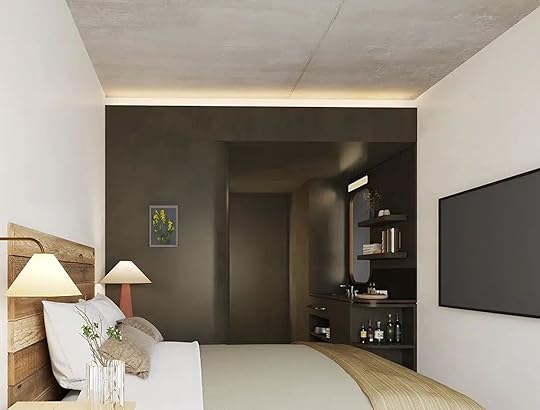 All room include a stocked mini-bar. Photo courtesy Populus
All room include a stocked mini-bar. Photo courtesy Populus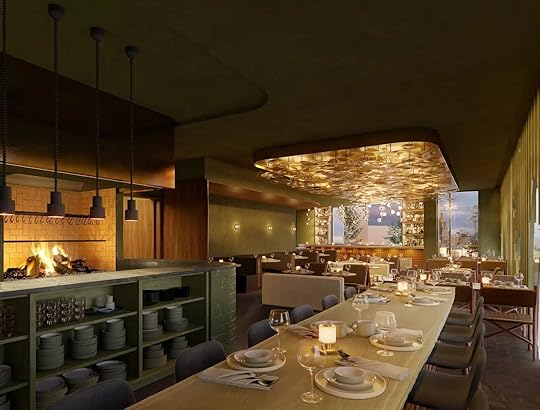 Stellar Jay, on the hotel's top floor. specializes in locally-sourced meals and cocktails with iconic city views from its balcony. Photo courtesy Populus
Stellar Jay, on the hotel's top floor. specializes in locally-sourced meals and cocktails with iconic city views from its balcony. Photo courtesy PopulusEntering my room on the hotel’s sixth floor felt like walking into a corner suite 20 years from now. Several “aspen eye” windows of varying sizes cast natural light across the space from the east, across the bed and desk/minibar and out the northwest windows with clock-like precision. Much the same as when camping, I could tell what time of day it was throughout my stay simply by following the flow of sunlight through my room. As an aside, the high concentration of windows resulted in a lot of curtain closing come bedtime (“so many curtains!” said my wife) but this is a small inconvenience for an overall pleasant experience.
The Populus guest experience is so well thought out that even basic trip-planning logistics are three steps ahead of the present-day norm. Notably, there is nowhere to park a car onsite. The eco-friendly ethos extends to the guest’s carbon footprint as well. The lack of dedicated parking means that arriving via public transit or bike is the most stress-free way to get to Populus. This bodes well with the increased use of environmentally-friendly “new urbanism” tactics increasingly deployed to new construction and remodel projects in cities and towns across the US, a successful example on a larger scale being Battery Park in New York City.
Surrounding the hotel are a run of separated bike lanes and the property is less than a block from public transit. I arrived in Denver via the Bustang intercity bus service, which deposited me at Union Station, a 15-minute walk from the hotel along Denver’s iconic 16th Street Mall. Guests flying into Denver International Airport can hop on the A-Line train to Union Station and enjoy the same walk, or hop on the free “Mallride” bus that runs right up 15th and 17th Streets. Rideshare drop off is easy right out front. Blocks away are downtown’s main attractions including the Colorado Convention Center, the Mall, and dining of every caliber from street food trucks to Michelin-starred restaurants. Drive yourself to the hotel and you’re already missing the point.
The in-room experience at Populus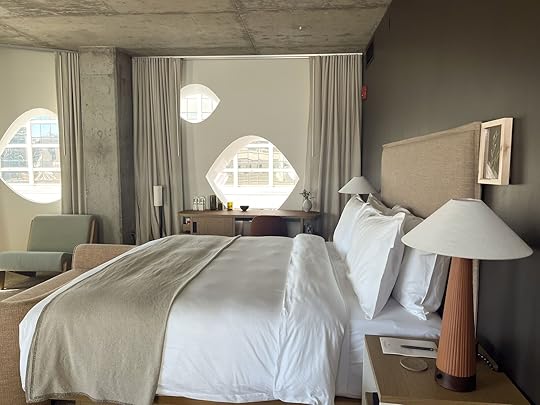 Natural light and colors defined my room. Photo: Tim Wenger
Natural light and colors defined my room. Photo: Tim Wenger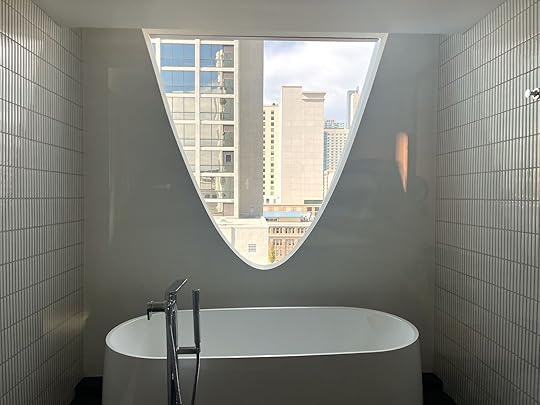 A bath with a view. Photo: Tim Wenger
A bath with a view. Photo: Tim WengerThree room types are available, includng. a 125-square-foot “Hammock Queen” featuring windowsill hammock suites or “Grove Queen” featuring a work desk in place of the hammock. Then there’s the slightly larger Deluxue king and finally the grand Corner suites, which feature 270-degree views and an expanisve bathroom with rain showerheads, a bathtub next to a window overlooking the skyline, and multiple sating areas. My room was quiet and serene. All rooms at Populus have either a windowsill seat in one of the iconic “aspen-eye” windows or a workdesk looking out through one. Mine had the desk, which I appreciated as I tend to do a lot of writing in hotel rooms. The mini-bar was stocked with locally made snacks, beers, wines, and spirits, of which I had a refreshingly aromatic gin and tonic using the Native Colorado Gin from Dry Land Distillers.
Rooms are tech-forward with motion-sensor lights in the bathroom and cordless phone chargers in the bedside nightstands.
The Serta Presidential Suite Euro Pillow Top bed was soft and nearly indulgent, lined with equally-fluffy pillows that put me right to sleep after a long travel day capped with dinner upstairs. Decor is minimalist but shuns no comfort, evidenced by the stacked mini-bar, coffee table books, and multiple seating areas. If a kitchenette and more closet space were added — there was just a small closet with five or so hangers — I could live in this room for an extended time.
A rain shower head and traditional spray shower, along with a handheld shower spout were available in the bathroom. The star, however, was the soaking tub with a window overlooking downtown skyscrapers including the “mailbox building” and Republic Plazze — never have I bathed with such an iconic city view. The bathroom was huge and featured reusable toiltetry dispensers and locally-made soap. The vanity featured a double sink and enough space that both my and my wife’s toiletry bags sat comfortably.
The gym, located on the second floor, is built for cardio and endurance training with Peloton bikes, treadmills, ellipticals, a stairclimber, and plenty of yoga and stretching mats. Freeweights are aplenty, abut there’s only one multi-purpose lifting machine.
Dining at Populus Fall Dellacotta Squash panko'd to perfection. Photo: Tim Wenger
Fall Dellacotta Squash panko'd to perfection. Photo: Tim Wenger The sweet potatoes paired well with the entrees. Photo: Tim Wenger
The sweet potatoes paired well with the entrees. Photo: Tim Wenger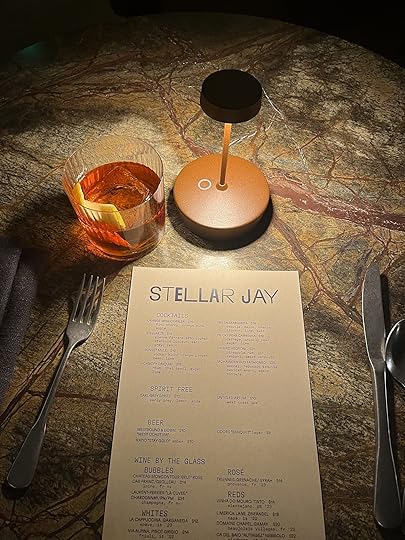 The negroni perfectly captured the spirit of Stellar Jay. Photo: Tim Wenger
The negroni perfectly captured the spirit of Stellar Jay. Photo: Tim Wenger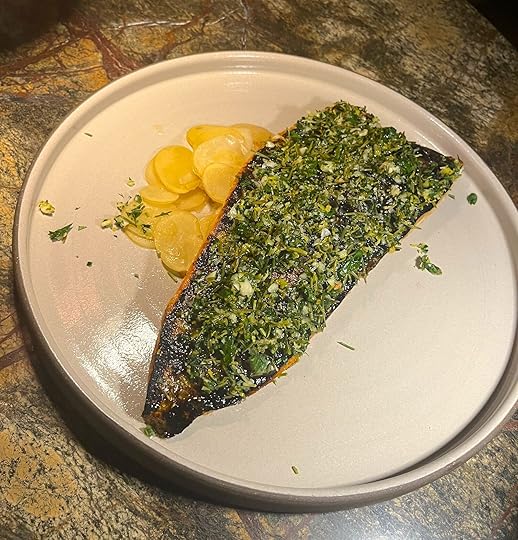 No dish in Colorado is more inconic than trout. Photo: Tim Wenger
No dish in Colorado is more inconic than trout. Photo: Tim WengerThis forward-thinking approach carries through the entire stay. Dining at Stellar Jay, the dimly-lit, shared-plate-centric rooftop bar and restaurant on the hotel’s top floor named for the common-in-Colorado Stellar Jay bird, I remarked to my dining partner that perhaps the greatest amenity Populus provides is freedom from making a bad decision. For travelers and diners like myself who try to be conscious of their consumer decisions, it is decidedly refreshing to enter a restaurant or a hotel and knowing that the tough choices have already been made. The plates are built to share and are delivered to the table “as ready.” Our party of three ordered several plates at once, and split them one by one as they arrived. Our server asked about allergies or restrictions. The small menu contained both veggie dishes and heartier options, and because ingredients are responsibly sourced I felt comfortable embracing my veggie-and-fish preferences knowing that I’d be full when the dinner concluded.
Deep, bold colors define the interior of Stellar Jay, much like its dark-blue namesake bird. The view outside on the balcony is dominated by the Colorado State Capitol building directly in front, the downtown Denver skyline rising to the north.
Little Owl Coffee, located in the lobby, served an excellent Americano and fresh croissant for breakfast. On my second night I dined with my wife and daughter at Pasque on the hotel’s lobby floor. The ambiance was clean and refined, like Stellar Jay, with an equally hearty menu of pasta, meats, and veggie-forward dishes.
A forward-thinking boutique hotel right when the world needs it Graphic courtesy Studio Gang
Graphic courtesy Studio Gang Graphic courtesy Studio Gang
Graphic courtesy Studio GangTucked into the bedside nightstand in my room at Populus was a copy of Douglas Chadwick’s “Four Fifths a Grizzly: New Perspective on Nature that Just Might Save Us All,” a rigorous, science-backed takedown of humanity’s perceived separation from the natural world. Chadwick argues that the modern urban environment stimulates our evolutionary “fight or flight” response to stress, spiking cortisol and adrenaline levels, and that the cure is to embrace, rather than fence out, nature. Reading these words in the second-floor lounge and coworking area at Populus, bustling on this Sunday morning, I thought about the rush and howl of the vehicles just outside on Colfax Avenue.
I thought about the expanse of concrete jungle that surrounded me, and how, while on a walk through City Center Park across the street, I’d felt a deep calm and satisfaction set in. The design team at Populus went to great lengths to mitigate urban overwhelm by creating a relaxing, natural-feeling space emblazoned by the woods of the Rockies. Essential oils waft the air, calling to mind that same relaxation taken from the outdoors. During the day, the hotel’s hallways remain dim – to the point that I couldn’t take a photo without the bright green “Exit” signs penetrating the shot. Though in the heart of the city, Populus embraces the natural world and, with the conveniences of a luxury hotel, the result is an incredibly comfortable place to base yourself.
To Chadwick’s point, I believe that humanity is catching on to our mistakes, our fear of the outside world, and our innate desire to conquer or control it. The ethos and practices of Populus, its planners at Urban Villages, and operators at Aparium are the type of forward thinking that society needs now. My three-year-old daughter’s generation must grow up surrounded by the progressive practices represented here. If Populus catches on and this type of hospitality spreads , we’ll be one step closer to healing ourselves and our planet. 
Where to Travel in 2025 Based on Your Astrological Sign
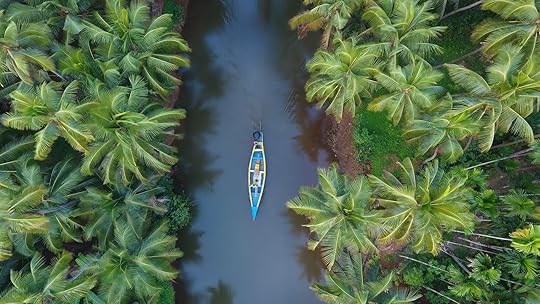
As a professional astrologer, I consider it my job to prepare clients for the dominant themes their lives will have in store in the near future, as reflected by the planetary shifts and transits. I think of checking astrology signs before setting off on a trip like viewing a weather forecast — why wouldn’t you want to know what’s ahead so you can prepare accordingly?
Different signs may find different experiences align best with what they are moving through, cosmically. People in signs who have more challenging transits may benefit from visiting more serene locales that are conducive for lots of rest and relaxation. People in other signs have more growth-oriented, adventurous energies aligning for them in 2025, so a travel destination that promotes more adrenaline and trailblazing may feel more in alignment. Tuning into your astrology helps you align to what your soul will crave in the year ahead and beyond, so you can truly feel like your trip is written in the soul.
Skip to your sign:
AriesTaurusGeminiCancerLeoVirgoLibraScorpioSagittariusCapricornAquariusPiscesJune looks particularly prosperous and expansive for travel. with a Jupiter cazimi (when the planet aligns with the sun) on June 24, Jupiter entering Cancer on June 9, and a Sagittarius (the sign of travel) full moon on June 11.
In the first portion of 2025 (from January 1 through June 9), Jupiter is in Gemini, which may boost short distance trips to local towns and locales that do not require getting on a plane. Uranus, the planet of all things unexpected, will also enter this sector of the sky from July 2025 onward, which can bring unusual events playing out in shorter journeys.
Another trend to expect for 2025 travels is a focus on revisiting the locations of one’s roots. This is due to Jupiter (the planet of travel) entering the sign of Cancer (the sign of home, roots, and ancestry) in June. This can lead to a drive among travelers to prioritize trips that allow them to connect deeper to their heritage. There also could be a boost in travel to destinations with a deep history and old architecture, as Cancer also governs history.
Neptune shifting from Pisces to Aries may also affect the priorities of travelers in 2025. Neptune has been in Pisces since 2011, which can influence jetsetters to flock to more spiritual locations. Neptune moves to Aries in late March, which may lead to the collective romanticizing of trailblazing new locations, idealizing adrenaline-laced adventures, and memorializing more rugged landscapes and terrains.

Photo: New Africa/Shutterstock
2025 travel destinations based on astrological elementsEach sign within the zodiacal wheel is associated with a different element, which helps us make sense of why the sign is the way that it is. You are not just one element — you’ll have to look at your full birth chart and get a sense of the dominant element representative within your energy. Tuning into the element that is the most strongly reflected in your natal chart can help you align yourself to circumstances, people, and places that align best with your natural constitution.
Fire signs: Aries, Leo, SagittariusFire governs life force energy, passion, and activity. With strong fire energy reflected in your celestial blueprint, you may be more drawn to travel experiences that are stimulating, with lots of activity, adventures and movement. You can find you get bored in places that are too slow or too off the beaten path.
Earth signs: Taurus, Virgo, CapricornEarth in astrology is associated with the senses: what we can see, taste, touch, smell, and hear. If you have earth featured heavily in your astrology, you may be drawn to travel experiences that speak to the senses — serene nature sights, delicious food, and indulgent spa experiences.
Air signs: Gemini, Libra, AquariusAir corresponds to the realm of communication, intellect, and the mind. If you have this element featured in your chart, you may find that travel experiences built around learning are a natural fit for you. Book trips to places that feature rich history for you to learn about, informative museums for you to explore, and cultures that are new to you.
Water signs: Cancer, Scorpio, PiscesWater aligns to the emotional, spiritual experience of being a human. Sites that hold spiritual significance for you may be powerful for you to explore. Having this element prominently featured indicates you’re a deep soul, and crave that same depth from your travels. You may also gravitate to places that are near a body of water, which can help refresh and restore your energy stores.
Where to travel in 2025 based on your zodiac signYour houses are dictated in your chart by your rising sign. Your rising sign is the most influential for your 2025 travel recommendations, as these forecasts were written with house transits in mind and will be the most accurate look at what influences you may experience in the year ahead. Secondarily, you can consider your sun sign (as in solar houses). The themes expressed by this sign may also be felt, just to a more subtle level.
Aries: Fairbanks, Alaska
Photo: youli zhao/Shutterstock
Ever the adventurer, you love embarking upon adventures in places that feel wild, rugged, and unexplored. What better location in the year 2025 than Fairbanks, a place to indulge in the wonders of nature and take in the midnight sun or the northern lights. Your trailblazing spirit will love exploring Glacier Bay National Park, or embarking on a flightseeing tour to fully take in the beauty of the terrain. Your bold nature aligns well with the elements you may endure in Alaska depending on time of year that you travel, but the Alaskan wilderness should renew and reinvigorate your energy stores.
The more serene scenery of Alaska aligns beautifully with the horoscope of rest and recuperation aligning for you in the upcoming year’s astrology. Last year, you had eclipses in your sign, which could have led to some dramatic transformations and shifts. In 2025, North Node will transit your twelfth house of solitude and Jupiter will enter your fourth house of emotions — both influences that may make you feel more inclined to relax, withdraw your energy, and recharge. Neptune will enter your sign late March, which could make you more sensitive to the world around you and more inclined to seek out spiritually renewing experiences. Your ruling planet, Mars, will be retrograde the first two months of the year, a time to prioritize resting and recuperating rather than traveling. You may also want to avoid traveling May through September, when the planet of responsibility and discipline enters your sign, bringing enhanced pressures on your life. Consider booking a trip for early December, to grab hold of the adventurous energy of your ruling planet in your ninth house of travel.
Taurus: Zanzibar, Tanzania
Photo: Denis Belitsky/Shutterstock
As an Earth sign, you live your life through your senses, and what a treat to indulge all of your senses via a trip to Zanzibar. You are known as the foodie of the zodiac, so expect to thrive embarking upon a spice tour in Zanzibar to learn more about the spices this island is known for: cloves, nutmeg, cinnamon, pepper. Don’t forget to stock up on spices at the Darajani Market. With Saturn and North Node transiting your eleventh house of friendships and communities, you may find you’re inclined to host many a dinner table in 2025 — the perfect time to share delightful cuisine and stories from your Tanzanian adventure with your guests.
Now, Taurus, with Jupiter transiting the third house from June onward this year, you’re more open to learning in the year 2025. But it’s in your nature to languidly luxuriate in between expeditions — Zanzibar has you covered with beautiful white beaches for you to bask in the sunshine and take in the beauty of the Indian ocean. Consider booking a trip the last week of the year to bring hold of the celestial focus on your ninth house of travel.
Gemini: Isle of Skye, Scotland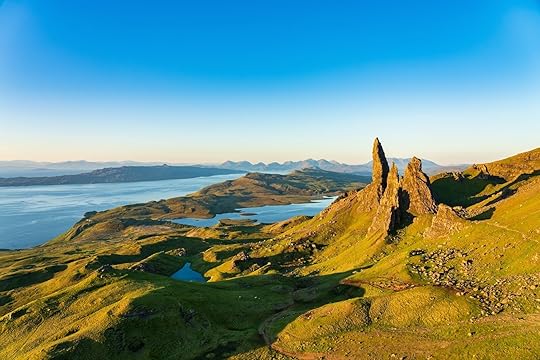
Photo: Pajor Pawel/Shutterstock
The eternal student of the zodiac, Geminis are always looking for pockets around the globe to investigate, learn, and discover. This desire within can be even more pronounced with Jupiter transiting Gemini in the first half of the year, bringing to the surface the desire within you to see new sights and learn new things. Consider planning a trip to Isle of Skye, where you can hike the mountainous landscape, take in medieval castles, tour the Fairy Pools, and spot the wildlife of the region to invigorate your curious nature.
While the planet of travel, expansion, and higher learning may have you inclined to blossom into new territories of your life, there is an immense pressure building within the arena of your chart governing career, public persona ,and reputation, with Saturn and North Node transiting your tenth house. This can lead to exciting gains and growth within your professional world, but you may be feeling more drained from the extra responsibility placed on you. You get a break from the planetary pressure May 25 through September 1 when Saturn (briefly) enters Aries, shifting the focus from the professional grind. Take advantage of this break from Saturn (while still making the most of Jupiter in your sign) by booking a trip late May or early June.
Cancer: Placencia, Belize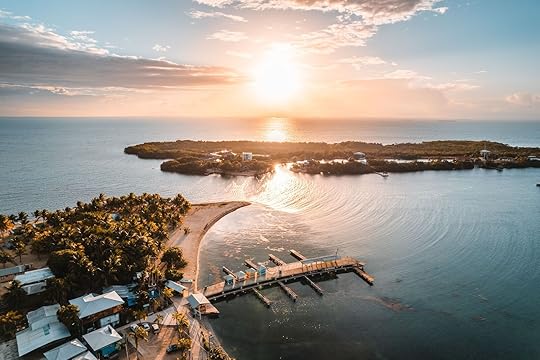
Photo: Wirestock Creators/Shutterstock
You feel more adventurous, more open to life, and more inclined to put yourself out there in the path of new opportunities and new locations from June onward in the year 2025. This is because Jupiter — the planet of travel, expansion, and adventure — will shift from your twelfth house of what’s hidden into the first house of identity, indicating a distinct tonal shift from your hermit era into an era of confidence and visibility. Take charge of this optimistic, exploratory energy by booking a trip to Placencia, a seaside village in Belize that will provide you the opportunity for all sorts of eye-opening adventures. Choose to climb a Mayan ruin, go snorkeling, hike through a rainforest — all in the same day, if you wish. Seize this open-minded and open-hearted Jupiterian influence.
While you may be open to more adventures and expeditions, the energy urges you to be cautious when it comes to your planning. Saturn, for most of the year, is transiting through the sector of your chart governing travel, which can bring delays and obstructions to your expeditions. Ensure that your travel documentation is in place and your travel plans are airtight. Saturn does briefly leave this section of your chart from May 25 to September 1, which presents a lovely opportunity for more seamless travel. Consider booking a trip around August 11 when the two benefics, Venus and Jupiter, meet up in your first house of self and identity. You may find you are feeling more inclined to seek out beauty, excellence, and adventure with these planets supporting you.
Leo: Waiheke Island, New Zealand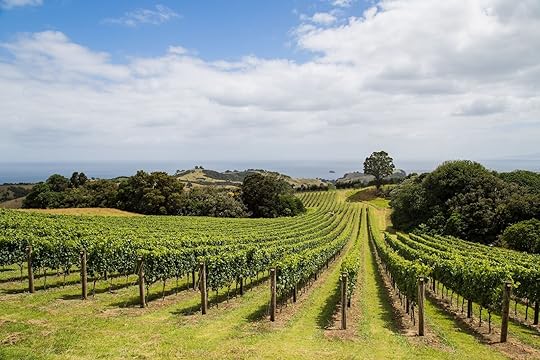
Photo: Naska Raspopina/Shutterstock
Ruled by the sun, you may be drawn to sun-soaked destinations that allow you to bask like the zodiacal lion you are. Consider penciling in a trip to Waiheke Island for beautiful beaches, pristine gulf views, and stunning olive groves and vineyards. Balance more adventurous activities like zip lining and kayaking with more sensual experiences like indulging in local oysters and the world-class wine of the region to honor both your adventurous fire sign nature and your desire to indulge in the regal, finer things in life.
When it comes to when to book, you may want to grab hold of the more sociable energies aligning for you in the first portion of the year, with Jupiter wrapping up its journey in Gemini. The latter portion of the year may prompt more introspection, contemplation, and solitude with Jupiter entering your twelfth house, which can be helpful in peaceful locations where you can hear yourself think. Neptune in Aries will influence your travel expeditions from March 2025 until 2039, which can make you feel more inclined to visit spiritual destinations. Grab hold of this more idealized, dreamy energy with your travels by booking a trip near May 2, when Venus aligns with Neptune in the travel sector of your chart.
Virgo: Crete, Greece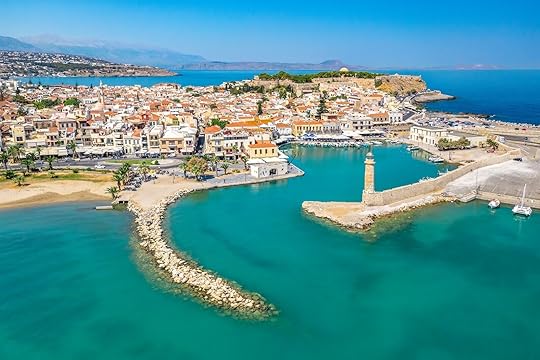
Photo: Sakis Papadopoulos/Shutterstock
As a Mercury-ruled sign, you are an intelligent, curious soul who wants to make the most of your trips by learning all you possibly can as you adventure. What better destination than Crete, where you can take in the ancient ruins and fascinating history of the Minoan civilization. Plan to tour the Palace of Knossos and Heraklion Archaeological Museum to learn all you can. As the grounded Earth sign you are, you have a special affinity for nature, and Crete boasts quite a lot of it. There are hikes at the Samaria Gorge, sunbathing at the Balos Lagoon, and awe-inspiring sunsets and picturesque canyons across the island.
When it comes to your 2025 travels and plans, know that your year ahead may be a bit more dramatic with the eclipses landing in your sign. Having South Node in your sign may prompt quite a bit of soul searching and contemplating who you are outside of who you’ve been before. Consider booking a trip to support this soul searching in late April and May to take advantage of the planetary concentration in the arena of your chart governing travel and spirituality.
Libra: Kerala, India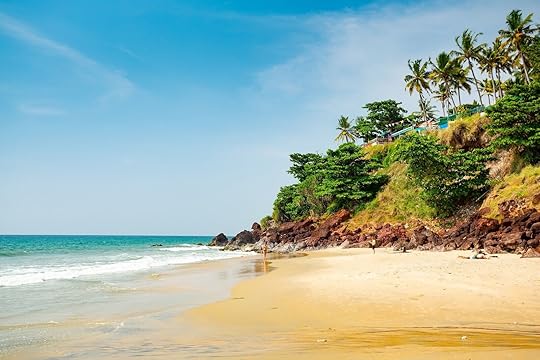
Photo: Florian Augustin/Shutterstock
As the sign of the scales, you are drawn to environments and places that promote the balance, peace, and beauty you thrive within. Kerala has a little bit of everything where you can balance more adventurous activities like houseboat cruises with mentally stimulating experiences like learning about the local cultural heritage and healing Ayurvedic treatments. Since your sign is notoriously a bit indecisive, Kerala features many different experiences and options for you to spend your time.
You’ve had a trying time last year with the eclipses in your sign, which could have led to challenges around your relationships and partnerships. In 2025, the focus shifts to your wellness: your physical, emotional, and spiritual well-being and healing (so beautifully aligned with the experience you would find in Kerala). You may find your trips in 2025 have some surprises and shockwaves in store, especially if you plan for after July 7, with Uranus entering Gemini (the sector of your chart governing travel and higher learning). Uranus governs all things unexpected and electrifying, so you may find that your trips are interesting (but exciting) detours. You will most certainly have some interesting travel tales to relay. Uranus can be exciting, but not the most stable, so perhaps book a trip in the first half of the year to avoid any detours you’re not prepared for. The Gemini new moon on May 26 can be a beautiful time to open yourself up to new places and new learnings.
Scorpio: Dampier Archipelago, Australia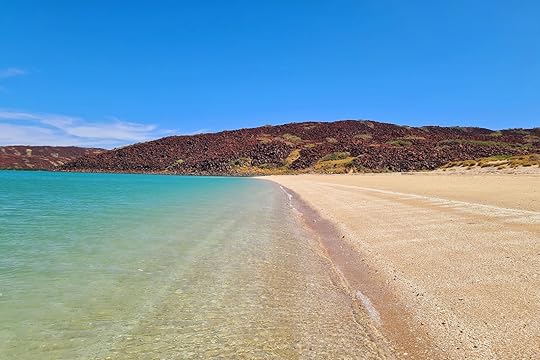
Photo: Franklin64/Shutterstock
You’re a deep soul diver, and you like to plunge into the depths where many others fear. Your investigative soul may feel magnetized to Australia’s Dampier Archipelago, a less traveled location that is deeply enriching. This island is more remote, so you can fully enjoy your privacy as you take in the beauty of the land. Soothe your water sign heart by taking in the coral reefs, sponge gardens, and plentiful abundance of fish.
2025’s astrology has never been so aligned for you to travel and adventure to new places and to unearth new wisdom, with the planet of travel entering the arena of your chart governing travel from June 9 onward. Consider booking close to June 24 to enjoy the Jupiter cazimi aligning in your ninth house, creating a celestial spotlight on adventure and exploration.
Sagittarius: Hanoi, Vietnam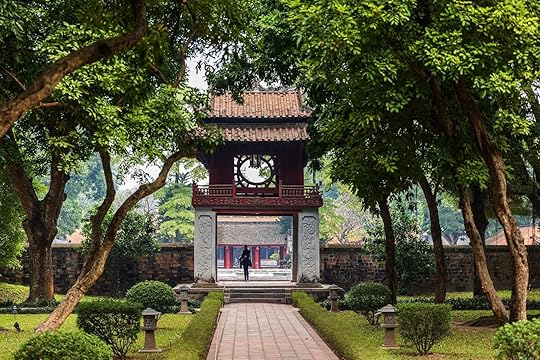
Photo: Framalicious/Shutterstock
As the quintessential adventurer of the zodiac, you are always looking to embark on new adventures to explore new-to-you sides of the globe. There is a perpetual desire within every Sagittarian to expand into new dimensions, whether that shows up within academia, travel opportunities, or spiritual quests. Sagittarius is known for a deep appreciation for culture and foreign lands. As you learn and adventure in Hanoi, delight in delectable street food, take in the robust Old Quarter, and soak up the temples.
While that Sagittarian wanderlust is always alive within you, there is a distinct focus in 2025’s astrology around prioritizing your emotional state, home life, and inner world. Consider booking a trip between May and September, when Saturn leaves the sector of your chart governing home life and may make you feel more free to book a trip. A particular opportunity for travel lands for you in August, when a majority of the planets are concentrated in the realm of life governing travel.
Capricorn: El Chaltén, Argentina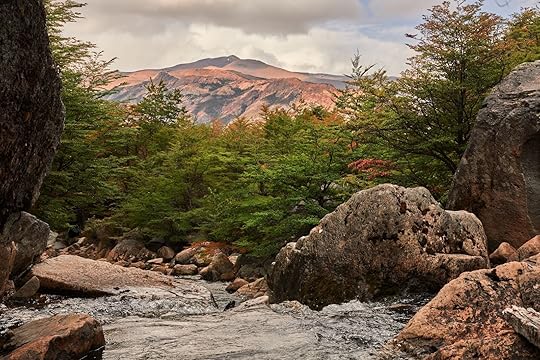
Photo: LeeSensei/Shutterstock
You are an ambitious soul, but with the current cosmic alignments, you may be feeling more inclined to prioritize the matters of your life that the outer world cannot see: matters of the soul, the family, and the home. You are a goal-setting, go-getter sign, but this year, you may be setting your sights on goals that are more intrinsically driven. Consider booking a trip to El Chaltén to indulge in some of the most incredible trekking in the world. Climb new heights and let the perspectives you may find on your ascent give you inspiration around what other “heights” you are inclined to reach.
With your ruling planet, Saturn, entering your fourth house of home for a brief stay mid year, you may find you are more inclined to invest your energy into being a homebody. Book September 2025 to enjoy the planetary concentration within your ninth house of travel and higher learning while experiencing a temporary relief of pressure in domestic matters, courtesy of Saturn in Aries.
Aquarius: Oslo, Norway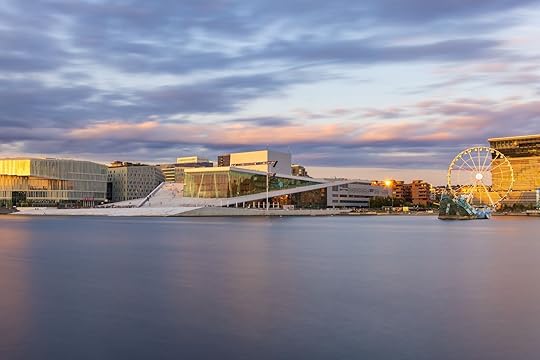
Photo: Simon van Hemert/Shutterstock
You are the humanitarian of the zodiac, so you may find you are inclined to travel to new locales that align with your beliefs and the world you believe in. Consider traveling to Oslo, a city that is committed to producing no greenhouse gas emissions by 2030. Additionally, this city will align with your curious, intelligent air sign nature with its wide variety of museums. Learn from the Fram Museum, Vigeland Museum, Viking Ship Museum, Akershus Fortress, or the Norsk Folkemuseum, to name a few.
Within the first portion of the year and Jupiter transiting your fifth house, you may find you are more inclined toward fun, creativity, and self-expression. Grab hold of this energy by planning a trip around the Libra full moon on April 12. This lunation spotlights your ninth house (the arena of the chart governing travel), making for a meaningful opportunity to see some new sights and contemplate some new viewpoints.
Pisces: Koh Phan Gan, Thailand
Photo: crowley production/Shutterstock
You’ve been a main character of recent astrology, and that continues in 2025. With eclipses and Saturn in your sign, you may be feeling a bit burnt out from all of the changes that the cosmos has in store for you. What better place to relax and refresh your energy than beautiful Koh Phan Gan. The jungle can ground you, the scooters can bring some adventure, and the beaches will restore your water sign soul. Of course, Pisceans are no stranger to a party, and Koh Phan Gan has no shortage of opportunities to celebrate and blow off some steam with the famous Full Moon Party, Half Moon Party, and Eden Garden Party, to name a few.
Even with the somewhat stressful cosmos, 2025 is a golden opportunity for you to travel. This is because Jupiter, the planet of expansion and your traditional ruler planet, will enter your ninth house of travel from June 9 onward, leading to soulful experiences when you’re adventuring to new places and in search for a new sense of meaning. While the latter half of the year presents many opportune pockets of time for your trips, consider penciling in a journey around August 12, when Venus and Jupiter meet up in your ninth house. This can lead to pleasurable experiences, beautiful sights, and even potentially romantic opportunities when you are open to adventure. Just plan for trips after August 11 so you avoid Mercury retrograde, thus avoiding any sort of potential travel snafus.
More like thisTravelThe 57 Most Exciting New Hotels of 2024October 20, 2024
Here’s How to How to Survive the Vatican Jubilee if You Visit Rome in 2025

As if Rome wasn’t already one of Europe’s — and the world’s— most popular destinations, the Vatican’s 2025 Jubilee is anticipated to push the city (and the patience of tourists) to its limit.
The Vatican Jubilee, also known as the Holy Year, is held every 25 years, save for a few “extraordinary years,” as designated by the Pope. The Vatican Jubilee invites religious pilgrims to journey to Rome and be granted plenary indulgence, among other Catholic rituals and events. The Jubilee is anticipated to draw huge crowds to Italy’s capital, with authorities anticipating 35 million pilgrims to arrive in Rome throughout the year. So, what does that mean for your trip to the Eternal City in 2025?

Millions upon millions of tourists will likely descend on Rome for the Vatican Jubilee. Benny Marty/Shutterstock
Tourists who unknowingly booked a trip during the Jubilee year may be wondering whether the city still worth visiting, or if rescheduling would be the wiser move. As a local who’s lived in Rome since 2017 and worked in tourism throughout that time, I know there are a number of ways to make the most of your trip despite the added excitement and challenges the city is sure to face during the year-long Vatican Jubilee.

Tours for top attractions like the Colosseum will fill up fast in 2025. Photo: Kristi Blokhin/Shutterstock
In a normal year, I recommend booking accommodations in Rome about six months in advance, guided tours two to three months ahead, and restaurant reservations one to two weeks before your trip. For high-demand restaurants, it’s ideal to reserve your space 30 days in advance (or whenever reservations open). If you’re staying at high-end hotels, the concierge may be able to assist in securing them.
But in 2025, forget those timelines. Once your trip dates are set, lock in your must-do activities and make reservations immediately, particularly for high-demand attractions like the Colosseum and the Vatican Museum.
With very few exceptions, guided tours in Rome will be bookable well in advance of your trip, and 2025 dates will likely fill up quickly. When possible, book directly with tour operators, rather than sites like Viator or GetYourGuide. In recent years, ticketing has changed at the Vatican and Colosseum to prevent bots from purchasing all the tickets. Now, every single ticket needs to have the guests’ first and last names. Third-party platforms skirt this by allowing a large number of tickets to be purchased before the tour operators have secured them, which can result in cancellations later on, often at the very last minute. Individual tour operators can book specific tickets with your name and information on them, making them less likely to be canceled.
For some attractions, you can book your tickets directly with the business, and you’ll want to set a reminder or alarm to secure them on the first available date. For example, for unguided entry to the Colosseum and Vatican Museums, you can book directly through the websites 30 days in advance.
For restaurants, check out Italian reservation apps like The Fork and Quandoo to secure a table during your trip, but keep in mind that some Roman restaurants only accept bookings by phone or through their reservation system on their websites. Be sure to visit the restaurant’s website directly to check on its booking process. Again, hotels and lodging hosts can often assist.

Rome’s historic center is a convenient place to stay, but likely to be even busier than usual in 2025. Photo: Nattee Chalermtiragool/Shutterstock
While it’s tempting to stay in the heart of Rome, the historic center’s constant influx of tourists can wear down even the most patient traveler. Instead, consider one of these more laid-back neighborhoods, offering a calmer home base while maintaining easy access to the city’s top sights. If you prefer to stay close to the action, don’t worry: the neighborhoods below are still plenty lively, but will allow you to experience a more local side of the city.
Nestled between the Colosseum and Termini Station, Monti is a hip neighborhood with cobblestone streets, vintage shops, and trendy bars. Its central location offers easy access to major landmarks, but its low-key piazzas and artisan boutiques give it a more local, intimate vibe. It’s still extremely central, with the Colosseum marking its southern border.
Trastevere

A busy street in Rome’s Trastevere neighborhood. Photo: ennar0/Shutterstock
Trastevere is a picturesque neighborhood known for its narrow, winding streets and vibrant energy. While it’s home to lively nightlife and some fantastic local restaurants (but beware of tourist traps!), its location just across the river from the main attractions makes it feel like a retreat from the crowded city center.
If you don’t want to be in the thick of the evening revelers, look for accommodation near Piazza San Cosimato, a more tranquil spot towards the back of Trastevere.
A quieter, more residential district, Salario provides a peaceful escape from Rome’s bustling tourist areas. With charming cafes and easy access to the expansive Villa Borghese park — a must-visit on your trip to Rome — it’s perfect for those looking to experience the authentic, everyday side of Roman life.
Prati

Mazzini Square in Rome’s Prati neighborhood. Photo: Aerial-motion/Shutterstock
Near Vatican City, Prati offers a more upscale, refined atmosphere often overlooked by tourists. The elegant neighborhood has wide, tree-lined streets, fantastic shopping, and less touristy restaurants. It borders Vatican City to the west, making it ideal for visitors who want to stay close to the Holy See without being in the thick of the crowds. It’s also worth noting that Prati is a large neighborhood with spacious streets and sidewalks, which helps prevent it from feeling too congested.
Visit less-frequented sites and museums
While a trip to Rome would be incomplete without visiting iconic sites like the Trevi Fountain, the Spanish Steps, the Roman Forum, and many more, the city is teeming with lesser-known sights, museums, and art galleries well worth the visit. Exploring these attractions can deepen your experience beyond the usual tourist route and provide a much-needed respite from the crowds.
The Doria Pamphilj Gallery

Photo: Suchart Boonyavech/Shutterstock
The Doria Pamphilj Gallery is hidden in plain sight, on Via del Corso just a few steps from Piazza Venezia. The gallery is the former palace of the Doria Pamphilj family — the same family that lends its name to Rome’s largest park in the city’s Monteverde neighborhood. The Doria Pamphilj Gallery is filled with luxurious furnishings and decor collected beginning in the 1600s, providing a glimpse into the opulent lifestyle of one of the city’s most well-known families. The gallery showcases an impressive collection of art, including masterpieces by Caravaggio, Raphael, and Titian.
Doria Pamphilj Gallery: Via del Corso, 305, 00186 Roma RM, Italy

Photo: Takashi Images/Shutterstock
One of four sites that make up the National Roman Museum, Palazzo Altemps is an aristocratic mansion in the fairly central neighborhood of Campo Marzio. It sits just steps from Piazza Navona, the most well-known public square in Rome.
While the architecture of the palace itself makes it worth the visit, visitors can also explore an intricate labyrinth of decorated rooms showcasing ancient sculptures, including pieces from some of the most-well known collections in Europe spanning different periods of Roman art history. That includes the Mattei Collection, with sculptures that once adorned the grand Villa Celimontana on one of Rome’s famous seven hills, as well as art from the Del Drago Collection, known for 15th-century reliefs that were nearly lost to illegal exporting. You’ll also see historical items, like the Ludovisi Throne, dating to 460 BCE.
You’ll likely get the most bang for your buck by buying in advance a combined ticket, which includes admission to each of the National Roman Museum sites over a seven-day period: Terme di Diocleziano, Palazzo Massimo, and Palazzo Altemps. It normally also includes the Crypta Balbi, but it’s currently closed for ongoing renovation work. It’s expected to reopen before the Vatican Jubilee, but no official date has been announced as of October 2024.
Palazzo Altemps: Piazza di Sant’Apollinare, 46, 00186 Roma RM, Italy

Photo: Cineberg/Shutterstock
Palazzo Bonaparte is in the heart of Rome, just two minutes down the road from the Doria Pamphilj Gallery, and hosts a variety of temporary exhibitions. The stunning palace is steeped in history and was once the residence of Napoleon’s mother, Letizia Bonaparte. Visitors can admire both the architectural beauty of the building, as well as the rotating art and cultural exhibits.
Palazzo Bonaparte: Piazza Venezia, 5, 00186 Roma RM, Italy

Photo: RODKARV/Shutterstock
Modern and contemporary art lovers, rejoice! The National Gallery is home to an extensive collection of Italian and international art from the 19th to the 21st centuries. The large gallery has the biggest modern art collection in Italy, including paintings, drawings, sculptures, and installations from Neoclassicism to impressionism, futurism, and beyond. It has art from Italian artists such as Umberto Boccioni and Antonio Canova, as well as other well-known creatives like Jackson Pollock, Claude Monet, Edgar Degas, and many more.
The National Gallery: Viale delle Belle Arti, 131, 00197 Roma RM, Italy

Photo: Mo Wu/Shutterstock
The Jubilee spans from December 24, 2024, to January 6, 2026, but certain event dates and weekends are expected to be more crowded than others. (There’s a full list of events on the Vatican Jubilee website). The most crowded is usually the opening of the Holy Doors at St. Peter’s Basilica on Dec. 24, 2024. It’s a highly coveted event, with crowds compounded by the fact that Rome usually sees large numbers of visitors over the holiday season.
In addition to the door opening at St. Peter’s, the three other Papal basilicas in Rome — the Basilica of San Giovanni in Laterano, the Basilica of Saint Mary Major, and the Basilica of Saint Paul Outside the Walls — will also experience an increase in visitors. Each of the four basilicas has its own Holy Door, and entering through them is believed to be the pilgrim’s chance for spiritual renewal and a way to forgive most atonement for sins. The Holy Doors are opened only during a Jubilee year, making it a once-in-a-lifetime experience for many.

Photo: Kristi Blokhin/Shutterstock
If you’re visiting Rome in 2025, being prepared and setting realistic expectations is key to enjoying your time during the Vatican Jubilee. With careful planning and a willingness to explore beyond the typical tourist spots, you can experience the city’s complex history and authentic culture without letting the crowds ruin your experience. But don’t worry if you aren’t able to visit all the sites you’d like to see. No matter how busy it gets, Rome’s charm and beauty ensure it’s a magical destination that will always beckon a second (or tenth) visit. You’ll never run out of things to do.
 More like thisArt + ArchitectureThis Tiny Peephole May Just Have the Best View in Rome
More like thisArt + ArchitectureThis Tiny Peephole May Just Have the Best View in Rome
October 19, 2024
This Cool Oceanfront Hotel Is a Straight Shot to Santa Monica’s Iconic Pier

Santa Monica has a split personality. As I discovered during a late summer getaway, that’s part of the coastal Southern California city’s charm. Downtown buzzes with urban energy. Fashionistas can hunt for fresh fits at upscale Santa Monica Place, which anchors Third Street Promenade where three pedestrian-friendly blocks brim with more shops, restaurants, and a farmers market. But steps away from downtown’s bustle, on the other side of busy Highway 1, pristine Santa Monica State Beach offers two miles of tranquil bliss, and fun for all ages at the Santa Monica Pier.
The Pierside, a new addition to the city’s hotel scene that’s located right across the street from the pier, proved the ideal base for my stay. Managed by Sage Hospitality Group, the 132-room property — formerly a Wyndham — underwent an extensive renovation in 2023. The result? A lifestyle hotel with a laid back yet chic beachy vibe.
Inside The Pierside: a coastal aesthetic, fresh California eats, and all the beach gear you’ll need
Photo: Courtesy of The Pierside
The Pierside’s inviting lobby has seating areas with contemporary furniture and decor in a calming sand-and-sea palette of taupe, blue, and cream. One exception, a pair of sunset-hued armchairs, delivers a pleasing pop of color. By the front window, small flames danced in a standalone retro gas fireplace. Though the weather was far from chilly, I could easily imagine parking myself there on a cooler day.
A wood-slat wall separates the lobby from the equally appealing Surfing Fox, which specializes in coastal California cuisine and serves breakfast, lunch, and dinner. Touches like retractable glass doors that open to a patio, built-in cushioned benches, and whimsical rattan front-porch “swing” seats create a relaxed, indoor-outdoor feel. The restaurant also has live music on Fridays and a bar with happy hour specials.

Photo: Courtesy of The Pierside
Upon checking-in, I discovered one of The Pierside’s most delightful amenities: The Board Shop. More of a neatly arranged display area by the front desk than an actual shop, it offers an array of items you can check out to dial up your pleasure on or off the beach. Along with boogie boards, surf boards, and skateboards, you’ll find things like board games and cameras. If vinyl tunes are your jam, borrow an old school record player. Or make your own music with a Board Shop ukulele. Guests get two hours of complimentary gear rentals daily.
Rooms at The Pierside: ocean, mountain, and city views
Photo: Courtesy of The Pierside
I’m a sucker for a window seat with a view, so I was thrilled to discover that my Coastal King room at The Pierside had the next best thing: a sectional sofa with a long chaise resting against a pair of floor-to-ceiling windows. I started my mornings there, sipping coffee brewed in the in-room coffee maker while drinking in the view of Santa Monica’s natural and human-made assets: the ocean, the Santa Monica Mountains to the west, and downtown’s high-rises and rooftops spread out below me. Added bonus: the sectional converted into a queen sleeper. Many of The Pierside’s rooms include sofa beds.
Whether you’re traveling solo, as a couple, or with the family, The Pierside has a variety of rooms to meet your needs. (And feel free to bring your pup along for the fun — the hotel welcomes dogs.) If, like me, you need to see water when staying by the beach, book a coastal room or suite with a partial ocean view. Or pay a bit less for accommodations overlooking neighboring Tongva Park or the Santa Monica skyline. Prices fluctuate, with standard rooms ranging from around $300-$600 per night, depending on the season. Standard suites start at about $450 per night.
All rooms boast plank floors and understated decor in soothing neutrals and blues that, like the rest of the hotel, evoke the coast.
Amenities at The Pierside: a sunny pool, Peloton bikes, and a can’t-miss mural
Photo: Courtesy of The Pierside
As someone who doesn’t have a great sense of direction, I appreciated The Pierside’s easy-to-navigate layout. Both the compact 24-hour gym — equipped with Peloton bikes, treadmills, elliptical trainers, and weights — and access to the outdoor pool are just down the hall from the front desk. Stretching up the side of the six-story hotel, a colorful mural by artist Shepard Fairey creates a dramatic backdrop for the small but appealing pool area. Another perk: The hotel provides reusable bottles for guests that can be filled at water stations on every floor, making it easy to hydrate while you play at the beach or elsewhere.
Things to do near The PiersideHit the Santa Monica Pier
Photo: Dorothy O’Donnell
Constructed in 1909, the Santa Monica Pier is a US National Historic Landmark that lures more than 10 million visitors annually. Many come for the rides and games at Pacific Park. Santa Monica is also where iconic Route 66 terminates, and the pier is its unofficial endpoint. Tourists from all over the world line up for selfies at the “End of the Trail” sign near the entrance. I decided to skip the photo op and head to the amusement park.
I’m a wimp when it comes to riding roller coasters, even relatively tame ones like Pacific Park’s West Coaster. But I got a vicarious thrill watching the red cars clack up yellow tracks high above the sparkling Pacific, before whipping their way around a web of tight curves to deliver their shrieking passengers back to earth. The old-fashioned carnival games were more my speed. Even though I didn’t win a giant stuffed animal, I had fun playing a couple rounds of ring toss.

Photo: Dorothy O’Donnell
Then I strolled to the end of the pier. The wooden timbers creaked under my feet as music from different performers mingled with excited laughter and the squawks of gulls dive-bombing for stray fries and funnel cake crumbs. A group of women broke into a line dance in front of one musician, bringing smiles to the faces of passersby. The refreshing ocean breeze grew stronger as I neared the end of the pier. There, I peered over the railing at fishermen on a platform below attempting to hook sand bass, halibut, and surf perch.
Santa Monica Pier: 200 Santa Monica Pier, Santa Monica, CA 90401
Really dig in at The Surfing Fox
Photo: Dorothy O’Donnell
I was starting to crave some seafood myself, so I headed to The Surfing Fox for dinner. Chef David Yamaguchi draws on his Japanese and Mexican heritage to concoct unique versions of some of the familiar dishes on the restaurant’s simple menu. Take the vibrant green edamame hummus that my friendly server recommended as a dinner starter. Seasoned with wasabi and furikake — a Japanese spice — it had just enough kick to wake up my taste buds.
Wonton chips on the side were a satisfying alternative to pita bread. I also enjoyed the street corn focaccia served with rich chipotle butter. Earlier that day, I’d noticed a server delivering The Surfing Fox’s fish and chips to an outside table. One tantalizing whiff, and I knew I couldn’t leave The Pierside without ordering them. Good decision — the flaky Icelandic cod, wrapped in golden crust, lived up to my expectations.
The Surfing Fox: 120 Colorado Ave, Santa Monica, CA 90401
Stroll through Palisades Park
Photo: Lux Blue/Shutterstock
After coffee in my room the next morning, I took a walk in pretty Palisades Park. Sandwiched between Ocean Avenue and bluffs that tower above the coastline, the park has a 1.8-mile path lined with palms and elegant old street lamps. Popular with joggers and walkers, it’s also a prime spot to catch sunset. On the way back to The Pierside, I made a pitstop for more caffeine at Espresso Cielo, where I savored my latte at an outdoor table.
Then I returned to the Surfing Fox for breakfast. I’ve had my share of disappointing avocado toasts, but I was totally stoked on The Surfing Fox’s take on the ubiquitous breakfast staple: a generous portion of avocado perfectly seasoned with smoky salsa macha (a Mexican condiment) and topped with ninja radishes.
Palisades Park: Ocean Ave, Santa Monica, CA 90401
Pedal to Venice or beyond
Photo: Dorothy O’Donnell
That afternoon, I rented a beach cruiser from Boardwalk Bike Rentals, located just south of the pier. The Pierside has complimentary electric bikes for guests, but they seemed like overkill for the flat Marvin Braude Bike Trail. Pedaling south, I passed iconic Muscle Beach where hard bodies showed off on the rings and balance beams. The gorgeous, 22-mile oceanfront trail meanders all the way to Torrance Beach, but I only went as far as Venice, a couple miles south of Santa Monica.
With separate sections for cyclists and pedestrians, the trail never felt too crazy or congested. I stopped to join a crowd of spectators marveling at the daredevil antics of skaters at Venice Skate Park, then ventured off the trail for a quick detour to the famed Venice canals. With their dainty, arched bridges that look like something out of a fairytale, and assorted small boats moored in front of lovely homes, the canals cast a spell on me.
Boardwalk Bike Rentals: 1619 Ocean Front Walk, Santa Monica, CA 90401
Swim or bodysurf in the Pacific
Photo: Dorothy O’Donnell
Back at The Pierside, I was ready for a dip in the ocean. I grew up just down the coast in San Diego and spent almost every summer day at the beach. After grabbing a beach chair from the Board Shop, I staked out a spot in the sand, then hit the water, a perfect 70 degrees. Bodysurfing Santa Monica’s gentle waves, then lazing in the sun with a book, transported me back to the carefree summers of my childhood.
Get one last taste of Santa Monica
Photo: Dorothy O’Donnell
Sadly, my time in Santa Monica was vanishing faster than high tide can wash away a sandcastle. That evening, I went back to the pier for dinner and to experience its festive nighttime energy and colorful lights. There are plenty of dining options, including sit-down restaurants like Bubba Gump Shrimp Company. But I made a beeline for Pier Burger, known for its tasty burgers and frozen custard.
Before checking out the next morning, I headed north on the oceanfront trail for breakfast at Back on the Beach Cafe, a casual eatery that’s popular with locals. Striped orange umbrellas protect tables that sit right on the sand, but because there was a wait for them, I opted to dine indoors where I was seated right away. The setting was just as pleasant, and I feasted on a veggie omelet, home fries and fresh-baked scone. Fueled for the long drive home to the Bay Area, I headed back to The Pierside, packed my bag, and hit the road.
Pier Burger: 330 Santa Monica Pier, Santa Monica, CA 90401
Back on the Beach Cafe: 445 CA-1, Santa Monica, CA 90402

Photo: Courtesy of The Pierside
Los Angeles International Airport (LAX) is the closest airport to Santa Monica. From the airport, hop on the 405 or 110 and head west for about 30 minutes. Rideshares are easy to secure at the airport, as well as to get around town, although Santa Monica is also known for being walkable. Add in public transportation options like buses and the light rail, scooter-shares, and the e-bikes that The Pierside provides, and you should have no problem getting around. 
Matador Network's Blog
- Matador Network's profile
- 6 followers



